PC
T&P
|
|
PERSONAL
CONSTRUCT
THEORY
& PRACTICE
|
Vol.7 2010 |
| PDF version |
| Author |
| Reference |
| Journal Main |
| Contents Vol 7 |
| Impressum |
| |
||||||||||||||||||||||||
| |
||||||||||||||||||||||||
| THE
CHANGE OF CONSTRUCTS FROM THE VIEWPOINT OF A THEORY OF CONSTRUCT IMPLICATIONS |
||||||||||||||||||||||||
| Dissertation Presented in Partial Fulfillment of the Requirements for the Degree of Doctor of Philosophy in the Graduate School of The Ohio State University |
||||||||||||||||||||||||
| by | ||||||||||||||||||||||||
|
Dennis
Neil Hinkle, B.A., M.A. |
||||||||||||||||||||||||
| The Ohio State University 1965 | ||||||||||||||||||||||||
| Editors' note This document has been scanned by Fay Fransella, Centre for Personal Construct Psychology at the University of Hertfordshire and formatted by Simone Cheli at the Centre for Research and Documentation, Institute of Constructivist Psychology, Padua, Italy. Words underlined in the original have been set in italics. Bibliographic references are indicated by numbers in brackets, as in the original. The format of the references has been left as in the original. | ||||||||||||||||||||||||
The author would like to acknowledge a profound sense of gratitude for the inspiration provided by his adviser, Dr. George A. Kelly. By so doing, the author joins those legions which for decades will acknowledge their indebtedness to this patient prophet. The many fine hours of conversation with Dr. Don Bannister and Mr. Ralph Cebulla and the interest of Ed Moore and Jack Adams-Webber were much appreciated. Finally, it was my wife, Joyce, who made this experience possible. TABLE OF CONTENTS CHAPTER I INTRODUCTION Ockham's razor is a sharp and bloody instrument. In the surgical excision of complexity, the user's unsteady hand all too often leaves the tissue of oversimplification as well as that of simplicity. In the meantime, human lives hang in the balance while “healers” debate the merits of their respective—and respectable—microscopic perspectives. Dr. Don Bannister (Visiting Professor, The Ohio State University, Spring, 1965; personal communication) recently made the observation that in all other sciences except psychology, a scientist's explanation for a given phenomenon is considerably more complex than the layman's explanation for the same phenomenon. The continuation of a rapacious reductionism in psychological theorizing with its resulting psychology of minimal men will, however, be rejected as being an inferior explanation by laymen, who assuredly have the good sense and wisdom to do so. Prof. George A. Kelly's Psychology of Personal Constructs, however, has as its starting point the complex personal constructions of a man's outlook on the world. It also has the audacity of being self-reflexive; that is, it applies to psychologists and their psychologizing as well as to those who are psychologized. Its focus of convenience concerns a human being's anticipations of the alternative constructions of his life. It has as its psychotherapeutic goal constructive psychological movement. It assumes that a man is not condemned by his past history. As such, it aspires to be “a psychology of the optimal man”—not the minimal man, but the optimal man,—man in the process of being human (37). The explicitly stated model of Man from the viewpoint of personal construct theory is Man, the scientist—one who predicts, wagers, anticipates, expects, and implies, for the purpose of further predicting, wagering, anticipating, expecting, and implying. The philosophy of constructive alternativism, upon which personal construct theory is based, says that the model of Man as a scientist is but one of the possible alternative constructions of Man. Personal construct theory, therefore, does not limit itself to the passing of judgments about what a man is, but rather it focuses on what a man is trying to be and the process of his becoming, that is, the process of constructive psychological movement. It is the process of the changing of personal constructs—reconstruction and psychological movement—that is the primary concern of this dissertation. The main question asked is “What determines the relative resistance to change of personal constructs?” In addition to some relevant empirical findings with respect to this question, the following contributions are also offered: 1. An initial formulation of a theory of construct implication. Briefly, this theory develops the idea that construct definition must involve a statement of the location of a construct dimension in the context of a hierarchical network of construct implications. Here, “implication,” “prediction,” “anticipation,” and “expectation” are regarded as being synonymous terms. The theory will offer some tentative definitions of personal construct theory terms from the viewpoint of an implicative network of construct relations. From this viewpoint, constructs will be regarded as having only one characteristic, quality, or property; namely, a construct has differential implications in a given hierarchical context. 2. Construct implication methodology. This research concerns itself with the relative resistance to change of personal constructs in a hierarchical context from the viewpoint of a theory of construct implications. The following three methodologies will be presented; a. The hierarchical method for the elicitation of superordinate constructs. This was developed to test several hypotheses about the hierarchical level of superordination of constructs. b. The relative resistance to slot change grid. Since the resistance to change of personal constructs is to be the major dependent variable of the study, this technique represents the procedure that operationally defines this variable. c.The implication grid. This procedure presents, in systematic form, the network of implications that relate a set of constructs in a given hierarchical context. Much will be said of it later. 3. Questions and suggestions for further research. The general approach of this investigation has raised a host of theoretical, methodological, and empirical questions. Hopefully, the reader will find these to be the most significant “results” of this dissertation. CHAPTER II REVIEW OF THE LITERATURE In view of the intentions of this research as set forth in the first chapter, this review will be limited to those studies conducted within the context of personal construct theory which relate to the general area of construct change. The dissertations of Landfield (40) and Levy (46) provide relevant reviews from other orientations. Levy, for example, includes research from information theory, experimental extinction, discrimination learning, intolerance of ambiguity, and rigidity. The body of personal construct theory research was reviewed and relevant studies were selected with the following two criteria in mind: (1) The constructs investigated or utilized in the research should be theoretically related to construct change. (2) The research should be capable of being interpreted in the light of a theory of the network of construct implications and should be suggestive of further research along these lines. Several of the various measures derived from the grid form of the Rep Test which relate to reconstruction are measures of constellatoriness, permeability, and propositionality. Bennion (2) and Levy (46) were concerned with the effects of invalidation on propositional and constellatory constructs. They operationally defined constellatory constructs as those which were significantly loaded on the general factor of a conventional analysis of the Repgrid. Flynn (7) investigated construct constellatoriness and cognitive complexity as related to role variability. He used the explanatory power of the first construct factor as a measure of cognitive complexity and defined the degree of constellatory structure as the explanatory power of the first figure factor on a Repgrid modification. He found that role variability was significantly related to construct constellatoriness, but not to cognitive complexity. In terms of a theory of construct implication, constellatoriness refers to the relation between a given construct and others such that a polar position on the given construct implies polar positions on the other constructs. Pre-emptiveness, from this frame of reference, means that a position on the given construct implies those poles of the other constructs upon which an element is not to be located, either because the element is outside the range of convenience of the other construct, or because the element is to be located on the opposite pole of the other construct, i.e., a prior constellatory relationship, e.g., “Psychologists are useful, not hyperbolic, and not illiterate.” What we mean by the degree of constellatoriness or pre-emptiveness presents an interesting question. The contrast of constellatoriness and pre-emptiveness would seem to be propositionality; however, these terms can perhaps more usefully be seen as the extremes of a continuum which delineates the degree of certainty—expressed as a probability function—as to the utility of implying, or pre-emptively not implying, certain construct relationships in terms of the principle of maximizing the total number of construct implications within the personal construct system. Propositional thinking thus implies a suspension of judgment (i.e., a superordinate construction) as to the implicative gain of each of the alternative patterns of construction under consideration. Constellatoriness and pre-emptiveness indicate an expectation of high probability that certain patterns of construction will increase the total implicativeness of the system more than others. Propositionality, constellatoriness, and pre-emptiveness are thus not seen as a quality of a single construct, but rather, as the probabilistic superordinate anticipation of the total implicative gain that would result if two or more construct dimensions were placed in an implicative relationship to one another. It is a superordinate statement about the probable utility of a given implicative network. When defined in this manner, a construct network may be either propositional or constellatory. The Repgrid definitions of constellatoriness used by Bennion, Levy and Flynn are based on the principle of frequency of conjunction; thus, if a wide variety of objects were to be entered on the Repgrid as figures, and constructs of color, shape, height, weight, and hardness were elicited, and if most of the objects were construed as heavy, hard, short, chartreuse, parallelepipedons, then, by the principle of frequent conjunction, these constructs would be said to be constellatory. In this example constellatoriness is clearly a function of the population sample. To say, therefore, that these particular constructs imply one another is a most tenuous assumption—although not an altogether unreasonable one. In view of this, the Implication grid technique developed in this dissertation provides a promising means of exploring the general problem of constellatoriness and propositionality of personal constructs. The constructs of permeability and range of convenience are theoretically related to construct change. Binner (4) and Gettesman (8) allowed people to mark a zero on the Repgrid if neither construct nor contrast could be applied on a figure, and used this as a measure of permeability-impermeability. Hess (10) used the same operation as a measure of the range of convenience of the constructs. This suggests that perhaps it would be more useful to define a permeable construct as one whose range of convenience is relatively unexplored. Once its range of convenience has been fully elaborated and clarified, it becomes impermeable. According to the theory of the present research, the convenience—or inconvenience—of relating constructs is a function of the effects such a relation would have on the respective implicative networks of each of the constructs. For example, if I combine a geometrical and a zoological construct and come up with a parabolic toad—the offspring of an exponential mother and a hyperbolic father—then my problem in assessing the implicative utility of such a union consists of finding points of compatible implications. What does the meaning of toads say about the meaning of parabolas, and vice versa? By contrast, where are the points of compatible similarity between the implications of the constructs of roundness and billiard balls? Or cubical billiard balls? Or compassionate psychological research? The meaning of this toad fetish for the present investigation is somewhat obscure, so let us return to the citing of scripture. The studies of Isaacson (13) and Cromwell and Caldwell (6) reported that ratings on personal constructs were significantly more extreme than on provided constructs. These results could be predicted from a theory of construct implications if the differential implications of personal constructs is shown to be significantly greater than the implications of provided constructs. That is to say, it would be more important to resolve constructional ambivalence on constructs of high implicative significance—due to the greater threat potential of misconstruction—than on constructs of low significance. Resnick and Landfield (54) in their investigation of the Dichotomy Corollary distinguished between logical dichotomous constructs (e.g., mature-immature) and peculiar dichotomous constructs (e.g., intelligent-bad). This suggests that peculiar dichotomous constructs represent a highly constellatory relationship between two constructs (e.g., intelligent-stupid and good-bad). A way of testing to see whether peculiar constructs represent a relationship of two construct dimensions would be to ask the subject whether all events which are described by the negation of one pole of the construct must necessarily be described by the opposite pole of that construct. Validation, invalidation, range of convenience, type and length of social interaction, focus of attention of the construer, perceived self-movement, constellatoriness, propositionality, and hostility are dimensions which have been utilized in the various investigations of the Experience Corollary. This corollary stated that a person's construction system varies as he successively construes the replications of events. These investigations are, therefore, relevant to the general problems of construct change. Bieri (3) and Lundy (48) assessed the effects of social interaction on construction. In a later study Lundy (49) specified other dimensions determining the direction of change in interpersonal perception. He demonstrated a relationship between incorporation and differentiation (focus of attention upon one self or upon another person) and the notions of assimilative projection and differential accuracy. It may be that these studies were pinning down some of the possible superordinate constructions about the process of construing another, e.g., “He is like me; unlike me. How do I see him; how does he see me; how does he see himself; how do I see my relationship to him; how does he see it; how does he see the way I see our relationship—or myself—or him, etc.?” Poch (53) investigated the shift change of constructs (change from one dimension to another) and found that such change was greater for invalidated constructs than for validated ones. Newman (51) measured construct change by the amount of element (Repgrid figures) switching on various construct dimensions. Among other things, he found that change—defined in this way—was more likely following invalidation on those constructs along which one perceives himself to be moving in time than on the stable self-constructs. Using the implication grid technique, one would expect to find that the selfmovement constructs would imply significantly fewer changes on other constructs under conditions of slot change than would be the case with the stable self constructs. The general hypothesis here is that change of subordinate implications (element switching) is facilitated by stabilizing the superordinate implications of a construct. For example, it would be more threatening to say to a beginning therapist, “You don't understand what your patient is trying to tell you” than it would be to say “You show signs of making a fine and sensitive clinician, but right now you don't understand what your patient is trying to tell you.” This seems to be an important principle which needs to be experimentally demonstrated. In addition to the above-mentioned threat interpretation of Newman's study, it is also likely that the stable self constructs are those along which movement is limited by the absence of an elaborated alternative, i.e., anxiety. Thus, movement on stable self constructs may be limited by either extensive implicative invalidation—threat—or the absence of an elaborated alternative—anxiety. The converse should also be true for the self-movement constructs. The general principle of maximizing the total number of implications within a construct system can also be related to the studies of Bieri (3) and Lemcke (45). The Bieri generalization gradient—also supported by Lemcke's dissertation—indicates that the generalization of construct change does not follow the classical generalization gradient as found in conditioning studies. Invalidation of a construct tends to stabilize those constructs which are most similar to it. This effect could be accounted for by a theory of construct implications if it is shown that the similarity of constructs is directly related to the degree of interrelatedness of their implicative networks. Thus, when invalidation of a construct threatens an implicative network with invalidation, stabilization of similar constructs will function to preserve the implicative utility of the threatened network to which they are related. For example, if being either a productive researcher or an efficient therapist implies one's usefulness as a psychologist, then invalidation of one of these criteria will probably lead a person to initiate a stabilizing strategy with respect to the other in order to maintain the conception of himself as being a useful psychologist. Is not this strategy reflected in the profession today? The relationship of these hypotheses to research in the field of cognitive dissonance is probably clear enough to require no elaboration. The implication grid provides a promising means for testing these notions. The paper by Howard and Kelly (12)—based on Howard's dissertation (11)—argued that changes in a person's behavior must follow his construing of the change. This follows from the Fundamental Postulate of personal construct theory. In terms of implications, this says that a person cannot move along meaningless dimensions and that he therefore cannot behave meaninglessly. The previously cited work of Levy (47) reported that after high invalidation reconstruction was greater on constellatory constructs (defined by high loading on the first Rep test factor), and that with increasing invalidation the increase of change for constellatory constructs was greater than the increase of change for the propositional ones. He also hypothesized that under conditions of low invalidation change of propositional constructs would be greater than change of constellatory constructs. The results were in the predicted direction, but did not reach significance. Bennion (2) was also interested in this same problem. Interestingly, he found consistent individual differences in that some subjects resisted change on constellatory constructs, while others resisted change on propositional ones. While Landfield (40, 41, 42, 4) was concerned with a movement interpretation of threat rather than the constellatory problem, his work—along with the research of Levy and Bennion—can be interpreted in light of construct implications. From this frame of reference, psychological movement—construct change—will be resisted when such a change is anticipated as leading to an imminent comprehensive reduction of the total number of predictive implications of the personal construct system (threat), or as creating a relative absence of predictive implications relating to the events with which one is confronted (anxiety). Stated in its non-defensive form, this is the corollary that a person always changes in that direction which he anticipates will maximize the total number of predictive implications in his system. This can be accomplished by either the expansion or clarification (definition) of his system, or both. Landfield, among other things, found that a person tends to perceive as threatening those people who are as he was in the past but no longer wishes to be and who expect him to be as he was in the past but no longer wishes to be, and that the individual will perceive himself as being less predictable to himself in social relationships involving threatening acquaintances than in those involving non-threatening acquaintances. This suggests an inferential incompatibility between a rejected past self construction and a person's present or future construction of himself, such that acceptance of the past construction is anticipated to create a reduction or absence of predictive implications. It is also assumed that when a construct subsystem is validated, invalidated, or found that its range of convenience does not cover the events in question, then this same determination can also be applied to those superordinate constructs which governed the process of constructing the subsystem in question. Constellatoriness and propositionality are regarded as being one class of such superordinate constructions, and not as qualities of particular construct dimensions. The constructions which determine the process of construing for various people constitute a vital research area. It is hoped that modifications of the implication grid will be useful in these areas. Finally, with reference to Landfield's paper (43) on the closeness of opposites—reaction formation, extreme behavioral transformation, etc., as considered from the point of view of personal construct theory, the above elaborated implication hypotheses would lead one to predict that behavioral transformation (slot movement) would occur only on those constructs which have well elaborated networks of implications for both poles of the construct. Indexing the implications of each pole of constructs will facilitate differential predictions with respect to the direction and ease of psychological reconstruction. CHAPTER III A FORMAL THEORY OF CONSTRUCT IMPLICATION AND CHANGE This chapter presents the background and initial formulation of a theory of construct implications, defines various corollaries and terms, and finally applies the formulation to the problem of construct change. Background and initial formulation This theory of construct implication arose in response to three observations. The first concerned the visual representation of construct subsystems. Kelly represents a construct as a straight line with a dot or small circle at each end. A subsystem consists of an unconnected cluster of such representations at various angles to one another in space. Perhaps due to an electronics background, I had tended to visualize subsystems in terms of three dimensional binary interconnected circuits and drew them in the form of three dimensional genealogical tables. The second issue concerned the conceptualization of constellatoriness and propositionality. Kelly (15, p. 155) writes “A construct which permits its elements to belong to other realms concurrently, but fixes their realm membership, may be called a constellatory construct” and “A construct which leaves its elements open to construction in all other respects may be called a propositional construct.” The degree of constellatoriness of a construct seemed to me—by analogy—to be something akin to the strength of a magnetic field eminating from each pole of a construct. The greater a pole's field strength, the greater the number of constructs which clustered around it. Also by analogy, the looseness and tightness of constructs seemed to have something to do with the elasticity of the line which separated the poles. The third issue dealt with construct definition. A superordinate construct “is one which includes another as one of the elements in its context”; a subordinate construct “is one which is included as an element in the context of another” (Kelly, p. 532). With the exception of the constructs at the top and bottom of a hierarchy, all other constructs are both superordinate and subordinate. Also, if a construct can be loose or tight, permeable or impermeable, propositional or constellatory from time to time, what then defines a construct? This constitutes the essential point of departure for this dissertation. For Kelly, propositionallty, pre-emptiveness, constellatoriness, looseness, tightness, permeability, impermeability, etc., are qualities or properties of a given construct. The only unchangeable quality of a construct is its dichotomous nature. Now, what if we accept the Dichotomy Corollary, but reject these other notions as being construct qualities, how then can they be usefully defined? This will be discussed shortly. According to Construct Theory, the function of a construct is anticipation. The Choice Corollary indicates that we anticipate events (e.g., other constructs) in order to expand or clarify our system of anticipations. Thus, construct theory assumes that a person always chooses those constructions which he anticipates will maximize the total number of anticipations within his personal construct system. The Fundamental Postulate indicates that a person's system of anticipations psychologically channelizes his anticipatory processes—his construing. The epistemological basis of this theory implies that constructs always anticipate or subsume other constructs, not things-in-themselves. Thus, the theory being formulated focuses on construct anticipations. In the present theory, the term “implication” has been substituted for “anticipation.” A polar position on a given dichotomous construct implies polar positions on certain constructs, and this polar position may, in turn, also be implied by polar positions on other constructs. The construct positions which a given construct implies are called the superordinate implications of that construct; when the polar positions on the given construct are implied by positions on other constructs—either singularly or in combination (disjunction or conjunction)—these construct relationships are called the subordinate implications of the given construct. It follows that the definition (clarification) of a construct would require a statement of both the subordinate and superordinate implications of each of its poles. Such a definition—in context—is called the range of implication of that construct. It is the sum of the subordinate and superordinate ranges of implication. The total number of implications in the range of implication of a construct could be used as a measure of the meaningfulness of that construct. The subordinate range of implication provides a measure of the level of superordination of a construct. The range of convenience of a construct (Kelly, p. 137) covers all those contexts in which the user found its application useful. In contrast, the range of implication of a construct is an index of the extensiveness of its subordinate and superordinate network of implications in a given context. It would thus be possible to investigate the ranges (plural) of implication for a given construct in various contexts. Let us now turn our attention briefly to the various forms of implication between two constructs; for example, construct A-B and construct X-Y. A wide variety of specific implicative combinations are possible, but four commonly observed patterns are the parallel, orthogonal, reciprocal, and ambiguous forms, which are described as follows: 1. Parallel; A implies X and B implies Y. (e.g., love-hate; pleasantness-unpleasantness). 2. Orthogonal; A implies X, but B does not imply Y; also A implies X and B implies X, but neither implies Y, (e.g., employed-unemployed; has income-has no income). Also, good-bad; evaluative-objective). 3. Reciprocal; A implies X and B implies Y and X implies A and Y implies B. (e.g., nervous-calm; tense-relaxed). This kind of a relationship suggests a functional equivalence of the construct labels. The significance of reciprocal implications in terms of a factor analysis of the implication grid will be discussed in Chapter VI. 4. Ambiguous; A and B imply X, and B implies Y; also A implies X and B implies X and Y. One subject, for example, when relating desirable-undesirable and realism-idealism, said that realism and idealism both implied desirable and undesirable aspects for him. Conflict theory and double-bind theory relate to these implicative dilemmas. Such situations seem to result from (1) an incomplete abstraction of the differences between the contexts in which the construct was used; or (2) in the case of the example above—the subject used one construct label for two independent constructs, e.g., realismidealism in the sense of testing ideas—not testing ideas and realismidealism in the sense of not having goals-having goals. When clarified, the subject could then relate each of these usages of realismidealism to desirable-undesirable in the unambiguous parallel form. In this sense psychological movement, conflict resolution, and insight depend on the locating of such points of ambiguous implication and the resolving of them into parallel or orthogonal forms. The logical combinations of poles, number of implications, and direction of implications suggest other forms, but this will suffice to indicate the territory opening up for this aspect of construct theory research. Corollaries So far we have said that constructs are dichotomus, i.e., have differential implications, and each pole has a subordinate and superordinate range of implication of the various forms described in a given context of usage. The range of convenience of a construct refers to the number of contexts in which it has been found to be useful. It is essential to maintain the distinction between the symbol of a construct (verbal labels, etc.) and the construct itself in a given context. The indexing of the range of implications is regarded as a necessary feature of construct definition. In view of these notions, let us now review several of the eleven basic corollaries of personal construct theory (Kelly, p. 103). 1. Organization Corollary: “Each person characteristically evolves, for his convenience in anticipating events, a construction system embracing ordinal relationships between constructs.” This says that construct implication is typically unidirectional, e.g. A implies X, but X does not imply A. Constructs will therefore vary with respect to the number of constructs implying them and the number of constructs which they imply. It should be noted that constructs may be used either conjunctively or disjunctively to imply a polar position on a given construct, e.g., A and B together imply X, but neither A nor B alone implies X; and either A, or B, or both, imply X. 2. Range Corollary: “A construct is convenient for the anticipation of a finite range of events only.” That is, polar positions on a given construct are implied by a finite number of polar positions on other constructs. This has been called its subordinate ranges of implication. The superordinate ranges of implication of a construct are similarly restricted. 3. Choice Corollary: “A person chooses for himself that alternative in a dichotomized construct through which he anticipates the greater possibility for extension and definition of his system.” Since either extension or definition results in an increased number of implications, the Corollary can be reworded to state that a person chooses for himself that alternative in a dichotomized construct through which he anticipates the greater possibility for increasing the total number of implications of his system. That is to say, a person always chooses in that direction which he anticipates will increase the total meaning and significance of his life. Stated in the defensive form, a person chooses so as to avoid the anxiety of chaos and the despair of absolute certainty. This corollary of maximizing the total number of predictive implications in one's personal implicative network provides the theoretical basis for the present dissertation. 4. Fragmentation Corollary: “A person may successively employ a variety of construct subsystems which are inferentially incompatible with each other.” In view of the Choice Corollary discussed above, this suggests that inferential incompatibilities will be resolved only when such a resolution is anticipated to maximize the total implicativeness of the personal construct system. This highlights the vital importance of the personal constructions about the process of construing for the general problem of construct change. 5. Modulation Corollary: “The variation in a person's construction system is limited by the permeability of the constructs within whose range of convenience the variants lie.” A construct is permeable “if it will admit to its range of convenience new elements which are not yet construed within its framework.” (Kelly, p. 79) Thus, permeability—“the capacity to embrace new elements” (Kelly, p. 80)—represents the yet unexplored range of convenience of a construct. From the viewpoint of construct implications permeability is equivalent to inferential compatibility. Thus, the variation in a person's construction system is limited by the inferential compatibility between the variants and those constructs within whose range of convenience the variants lie. (The variation is also limited in accord with the principle of maximizing the total implicativeness of the construct system.) Terms This initial formulation of a theory of construct implication also suggests a number of tentative definitions of various other personal construct theory terms: 1. A construct. Earlier we indicated that construct definition should include a statement of the subordinate and superordinate implications of the construct. The problem here is how much can these implications change from context to context before the identity of the construct is lost? Essentially, a construct is a specific basis for differential anticipations or responses. Since a given construct symbol may represent a variety of specific bases (constructs), it is important that a construct and its symbol not be equated. For example, what a person considers to be “honest” in the context of criminals may be vastly different from “honest” in the context of intimate friends. Since the subordinate and superordinate implications of “honest-dishonest” could be expected to differ widely between these two contexts, in what sense could we say that the same construct is being used in each situation? The trans-contextual identity of a construct can perhaps be defined as the points of identical subordinate and superordinate implications. For example, if in context X, A, B, and C imply honesty, and honesty implies 1,2, and 3 while in context Y, A, D, and E imply honesty, and honesty implies 1, 4 and 5, then the trans-contextual identity of honesty consists of A and 1. This definition is definitely a tentative one. 2. Looseness-tightness. This refers to the variability of the predictions made from a construct. A loose construct can be defined as one whose superordinate implications, or subordinate implications, or both, vary from context to context, e.g., its classification criteria and/or its significance may vary. Notice that it is possible to loosen or tighten independently either the superordinate implications or the subordinate implications, as well as to loosen or tighten both. Thus, it is possible for a person to be loose about what constructs imply one's position on a given construct and tight about what that position implies—or vice versa—or both. Defined in this way looseness-tightness describes the extent of variability or construct relationships and not qualities of a particular construct. This definition is also tentative and needs refinement—especially in terms of the limits that inferential compatibility places on loosening and tightening and the maintenance of the trans-contextual identity of constructs. 3. Subordinate and superordinate constructs. In an implicative relationship between two constructs that construct which implies polar positions on the other construct is called the subordinate construct; that construct whose polar positions are implied by the other construct is called the superordinate construct. 4. Core and peripheral constructs. This distinction separates constructs according to the net loss of the total number of implications 24 which would result if the construct dimension were to be removed from the construct system. Peripheral constructs are those whose elimination—or addition—would not appreciably alter the implicative utility of the system. 5. Permeability-impermeability. The permeability of a construct refers to the number of new constructs with which it is found to be inferentially compatible. In this sense, it is the yet unexplored range of convenience of a construct. 6. Propositionality, constellatoriness and pre-emptiveness. This has been previously discussed at greater length in Chapter II. With respect to the principle of maximizing the total significance of the construct system, these terms refer to the degree of certainty one has about the implicative utility of relating (or not relating—in the pre-emptive case) certain construct dimensions. As such, they are superordinate constructs about various construct networks and not qualities of particular constructs. Propositional thinking means that one has suspended judgment about the ultimate significance of the various construct patterns under consideration. Constellatoriness and pre-emptiveness mean that such a judgment has been rendered. One may frequently relate certain construct dimensions either because one is certain of the utility of the particular relationship, or because no alternative relationships have yet been envisioned. 7. Anxiety. Anxiety is the awareness of the relative absence of implications with respect to the constructs with which one is confronted. 8. Threat. Threat can be seen as the awareness (e.g., a superordinate construction and anticipation about the construct system) of an imminent comprehensive reduction of the total number of predictive implications of the personal construct system. Landfield (40), for example, using a content approach to threat, found—among other things—that the possibility of accepting a rejected past self construction was threatening. The acceptance of a rejected past self construction would not leave a person without predictive implications, but—presumably—the person anticipates that the acceptance of the rejected construction would result in a net reduction of the total number of predictive implications as compared with his present implicative network due to the inferential incompatibilities between the past and present self constructions. Threat, then, is the anticipation of a net implicative loss. (In addition, the construction of one's construct system as either having suffered a substantial, unalterable implicative loss, or as being no longer expandable, might provide a useful basis for a theory of depression.) The initial formulation of a theory of construct change Within the general context of personal construct change, three types of change can be delineated. Shift change refers to a change from one construct dimension to another, e.g., viewing a person along a mature-immature dimension, then shifting to an honest-dishonest dimension. The change from one alternative of a dichotomus construct to the other alternative is called slot change, e.g., viewing a person as mature, then regarding him as immature. Scalar change is a slot change in the magnitude used to describe a construct alternative, e.g., less mature and more mature in contrast to immature. The focus of convenience of this dissertation concerns the slot change of personal constructs. From the viewpoint of construct implications, the Choice Corollary says that a person chooses for himself that alternative in a dichotomized construct through which he anticipates the greater possibility for increasing the total number of implications of his system. Thus, a person would resist movement in the direction of reduced implicativeness (threat) or the relative absence of implications (anxiety). The Modulation Corollary indicates that the variation in a person's construction system is limited by the inferential compatibility between the variants and those constructs within whose range of convenience the variants lie. It follows, then, that slot movement would be more likely to occur on those constructs that have a similar number of implications for each pole and for which each set is equally compatible with the rest of the construct system than would be the case for constructs of a markedly unequal number of polar implications, or constructs for which the acceptance of one of the sets of polar implications would lead to extensive inferential incompatibilities in terms of the rest of the system. Also, slot movement is more probable on constructs of few polar implications, because the anticipated threat and anxiety would be correspondingly less. The Organization Corollary says that construct implication is typically unidirectional, that is, constructs on one level imply the polar positions of constructs at the next level and these constructs in turn imply polar positions on constructs at a still higher level, and so on, so as to form construct hierarchies. The higher up the hierarchy a construct is located, the greater will be the number of implications in its subordinate range of implications, e.g., the more constructs that will be needed to define its polar positions. Thus, if one knows his polar position on a construct functioning at a high level of superordination, then he can also probably anticipate his polar positions on the wide variety of subordinate constructs which imply that position. That is, the polar positions of a superordinate construct can be used to monitor probabilistically the polar positions of constructs within its subordinate range of implication. Since the polar positions of constructs operating at a high level of supeordination should have a broader range of implication, it is expected that they will also show a greater resistance to slot change than constructs functioning at a low level on the hierarchy. This is predicted, because the degrees of threat and anxiety are assumed to be a function of the number of implications available. The relative resistance to slot change of personal constructs is the major dependent variable of the study discussed in the following chapters. This will be related to the polar implications of constructs and their hierarchical level. In addition to a number of issues which will be discussed subsequently, this study provides a test of the utility of a number of formulations which have been presented in this chapter, particularly the Choice Corollary. CHAPTER IV PROCEDURE, INSTRUMENTS, SCORING, AND SPECIFIC EXPERIMENTAL PREDICTIONS Introduction and general hypotheses The purpose of this study was threefold: Primarily, it attempted to develop a methodology whereby a person could communicate aspects of his networks of construct implications in a standardized and systematic fashion. Hopefully, these systematic representations would then provide a fertile basis for the generation of a number of hypotheses for further research exploration. Secondly, the study would provide the information necessary for an internal analysis of the characteristics of the implication grid methodology itself. As it turned out, many of the important characteristics of the implication grid had not been realized until after the data had been collected. Finally, specific predictions about the change of personal constructs—which had been derived from the theory of construct implications—would be tested. This would provide a demonstration of the utility of the theory and associated methodology. The four general hypotheses which were derived from construct implication theory and investigated in this study are as follows: 1. The relative resistance to slot change of personal constructs will be directly related to the superordinate range of implications of those constructs. This is based on the principle of maximizing the total implicativeness of the system and the notion that the anticipated degree of threat will be a direct function of the number of implications involved in the change. 2. Constructs functioning at a higher level of superordination in a hierarchical context will have a larger superordinate range of implications than constructs functioning at a low level. This would not be predicted for constructs functioning at the highest level of superordination in a hierarchy. 3. Constructs functioning at a higher level of superordination in a hierarchical context will have a larger subordinate range of implications than constructs functioning at a low level. 4. Constructs functioning at a higher level of superordination in a hierarchical context will show a greater relative resistance to slot change than constructs functioning at a low level. (This hypothesis assumes the validity of hypothesis 2, above.) Although the data permit the testing of a number of additional hypotheses (to be elaborated in Chapter VI), these were the ones of principal interest in this initial investigation of construct implication. The exact operational definitions of these hypotheses will be presented following a discussion of the general procedure, instruments, and scoring methods. Subjects The subjects of this experiment were undergraduate students taking Psychology 401, an introductory psychology course. As part of the course requirements, each student was required to participate as a subject in four hours of psychological experimentation. The signup sheet for this study stated simply that it was a four hour extensive personality interview; that the results were completely confidential; and that each subject would have an opportunity to have the mathematical analysis of his interview explained if he requested it. A total of 28 people participated in the experiment—11 males and 17 females. The mean age was 20 years with a range from 18 to 31. Most of the subjects were in their freshman or sophomore year in college. Procedure 1. The introduction. When a subject appeared for his “personality interview” he was told that we were interested in having him explain himself to us in a particular fashion which could later be mathematically analyzed. The results of the interview would be explained to him later if he wished and they were completely confidential. He would be free to leave with the full four hours of experimental credit as soon as he completed the interview. (The average running time per subject was actually just under 3 hours.) The subject was informed that 5 minute breaks would be taken after each major section of the interview, and that breaks could be taken at any time the subject requested them. 2. Elicitation of figures. The subject was then asked to give the first names of nine people who currently played an important role in his life and whom he knew well. Parents, siblings nearest the subject in age, boy friends, girl friends, employer, and roommates were suggested as possible figures. The only restrictions placed on the selection of figures were that the subject must have known the person for at least 6 months and must regard the person as currently playing an important part in his life. 3. Elicitation of the ten subordinate constructs. Since the hierarchical context used in this study was to be the subject's construction of himself as he would prefer to be, triads were generated utilizing all nine of the elicited figures and the subject himself as one of the elements in every triad. Using the subject as an element in each triad assures that the elicited constructs will be self relevant. In order to generate the first subordinate construct the subject is told, “We are interested in understanding you and these people who play an important part in your life. Now think about these three people for a moment: Yourself, (person's name), and (person's name). Is there some important way in which any two of these people are alike in contrast to the third?” The process is repeated nine more times using new triads in each case. After the subject generates his first construct, he is asked not to repeat any construct which he has previously given; that is, he is asked in effect to generate ten constructs which for him are clearly different from one another. When he has generated ten constructs using himself and all nine of the figures, he is then asked to read over the list in order to assure that none of the constructs is merely a rewording of some other listed construct. If, after this, some of the constructs appear to be similar to the experimenter, the experimenter then asks the subject to explain the differences between the particular constructs in question. When both the subject and the experimenter are satisfied that the ten elicited constructs are clearly different from one another, then they proceed to the next step. 4. Side preference of the subordinate constructs. The subject is now asked to indicate which side of each construct dimension is clearly descriptive of the kind of person he prefers to be. It is indicated that he is not being asked which side describes him now, but rather which side describes his preferred self-construction. Occasionally a construct will have no clear side preferences (i.e., both sides preferred or neither side preferred); in this case, new constructs are generated from the triads until the criteria of step 3 above, and this step are satisfied. This requirement of a clear side preference is made in order to assure that the constructs will have clearly differential implications. These ten constructs are entered in the implication grid as constructs 1 through 10 and constitute the subordinate constructs of the preferred self-construction hierarchy. 5. The hierarchical technique for eliciting the superordinate constructs of the preferred self hierarchy. The subject is now asked to construe the superordinate implications of his subordinate constructs. His first subordinate construct is selected and he is instructed as follows: “Now on this construct you preferred this side to that side. What I want to understand now is why you would prefer to be here rather than there (pointing). What are the advantages of this side in contrast to the disadvantages of that side, as you see it?” The subject will now generate a construct dimension which has a preferred side. (Subject 4, for example, said that he preferred to be reserved in contrast to emotional, because being reserved implied being relaxed while emotional implied being nervous; thus relaxed-nervous is his first superordinate construct in the preferred self hierarchy.) The subject is stopped and the same question above is asked of the construct which he just generated. (Subject 8 replied that being relaxed implied a better performance, while nervous implied a poorer performance; thus better performance-poorer performance is his second superordinate construct.) The subject will again generate a construct with a clearly preferred side. The same question is now asked of this construct. The process is continued until (1) the subject can no longer generate a construct dimension or (2) until he has generated ten such superordinate constructs which he regards as being clearly different, though related, from one another and for which he has indicated a clear side preference. If he reaches the top of his hierarchy before he generates ten different constructs as he sees them, then the second subordinate construct is selected and the process repeated until the ten superordinate constructs have been elicited. Earlier pilot work showed that people can typically generate about 8 to 12 such superordinate constructs (using subordinate constructs elicited as described) before reaching the top of the hierarchy. In the pilot work, the complete hierarchies for each of the ten subordinates were elicited. While this was most interesting information, it was time consuming to obtain. Fortunately it was found—as is theoretically expected in construct theory—that the chain of superordinate constructs in the hierarchy generated from the first subordinate was almost invariably repeated in the hierarchies of the remaining subordinates. That is to say, we were tapping into the general construct hierarchy about one's preferred self at various subordinate points. The Organization Corollary predicts that the lines of implications of these constructs should converge at higher levels of superordination, and this is exactly what was found. It should be emphasized that the specific information yielded by this hierarchical technique is enormously suggestive of further theoretical research. Subjects were extremely interested and involved with this part of the experimental procedure, because—in effect—they are being asked to delineate some of their most fundamental commitments in their present life. They are at the same time rank ordering these commitments in terms of a scale of values—or over-arching principles of choice. Unfortunately, the content of these hierarchies is only very tangentially related to the interests of this present dissertation, but let me strongly invite the reader to spend a few minutes exploring his own construct system—or that of a friend—with this technique. Constructs functioning at this level of superordination are of fundamental importance; an awareness of them is essential for understanding the world of another human being—or ourselves. (In keeping with the philosophy of constructive alternativism, let me quickly append a propositional “perhaps” to that last statement! The invitation, however, still stands.) The themes of achievement and affiliation were frequently observed in the hierarchies of the people participating in the study. This reflects the vocational and interpersonal concerns which seem to typify late adolescence in this subculture. The following is a sample of those constructs which terminated (i.e., the most superordinate constructs) the hierarchies of the subjects: get less-get more out of life; have purpose in life-have no purpose; accomplish more-accomplish less; happy-unhappy; life-death; good time-bad time; satisfaction-frustration; feel wanted-feel unwanted; stimulating-dull and boring; new ideas-same ideas; goals-no goals; cold feeling-warm feeling; clarity-confusion; more fun-less fun; moody-stable; people will help you-people won't; miss a lot-have good times; have respect of others-be a social outcast; more knowledge-less knowledge; change-sameness; be worth while-be worthless; and fulfilled in life-unfulfilled. For Kelly, the principle that subsumes all choice points is the principle of the Elaborative Choice, the Choice Corollary. In construct form, this principle might be worded as: expands or clarifies my outlook versus reduces or obscures my outlook. Personal construct theory assumes that this is the ultimate principle of choice. Construct alternativism implies that there could be others. The subject is now asked to review his list of superordinate constructs to assure that they are different from one another. The ten superordinate constructs are then entered on the Implication Grid as constructs 11 through 20. 6. The determination of the relative resistance to slot change of the elicited constructs. The twenty elicited constructs are presented to the subject two at a time in such a way that each construct is paired with every other construct. They are written on 3" x 5" cards, and the preferred side of each construct is indicated with a check mark. Constructs I and 2 are presented to the subject. He is instructed: “Look at these two constructs. The check marks indicate the sides you said you would prefer to be on. Now, let's assume for the moment that you had to change from the preferred side to the unpreferred side on one of these constructs, but could remain the same on the other. Which of these two constructs would you prefer to remain the same on? Remember, you will have to change on the other one. What we are trying to find out here is if you had to change which of these two changes would be the more undesirable, as you see it? We would prefer you to make a choice whenever possible, but there are two circumstances in which you will find it impossible to make a choice. The first is when the two changes both appear to be undesirable to exactly the same degree. In most cases, however, you will be able to detect some difference between the two which will enable you to make a decision. The second instance is when it is not logically possible to change on one construct and at the same time remain the same on the other. This is the case where changing on one construct logically implies that you must also have changed on the other construct. Let me know when either of these two circumstances occurs. Any questions?” Construct 1 is now paired with all other constructs, then it is removed from the deck, and construct 2 is paired with all of the remaining constructs; it is then removed. This process is continued until all the constructs have been paired together with all other constructs. The relative resistance to slot change of the twenty constructs can be determined by rank ordering them in terms of a scoring formula which takes into account the number of times each construct resisted being changed during the pairing sequence. The exact scoring procedure will be discussed later. The resistance to slot change grid for each subject is included in the Appendix. 7. The implication grid technique. Basically, the implication grid is a matrix of the superordinate and subordinate implications that interrelate a set of constructs. In this study only those relationships of implication which were of the parallel or reciprocal forms were indexed. The subject was instructed as follows: “Consider this construct for a moment (construct 1). Now, if you were to be changed back and forth from one side to the other—that is, if you woke up one morning and realized that you were best described by one side of this construct while the day before you had been best described by the opposite side—if you realized that you were changed in this one respect—what other constructs of these nineteen remaining ones would be 1ikely to be changed by a change in yourself on this one construct alone? Changing back and forth on just this one construct will probably cause you to predictably change back and forth on which other constructs? Remember, a change on just this one construct is the cause, while the changes on these other constructs are the effects implied by the changes from one side to the other on this construct alone. What I'd like to find out, then, is on which of these constructs do you probably expect a change to occur as the result of knowing that you have changed from one side to the other of this one construct alone. A knowledge of your location on this one construct could probably be used to determine your location on which of these remaining constructs?” Construct 1 is then paired with each of the remaining constructs. The subject then indicates in effect the superordinate implications of parallel or reciprocal form of construct 1 with respect to the set of constructs. This same process is repeated for each of the twenty constructs so as to index the superordinate implications of each construct with respect to the remaining set of nineteen. After completing the implication grid, the subject has—in effect—construed 21 different personalities for himself. Each of the 20 columns on the implication grid represents a possible alternative self-construction which the subject has envisioned. The twenty-first personality is his preferred self construction, and this is represented by his side preferences on the 20 constructs. The facility with which people complete this task is remarkable; it hints at the complexity and multitude of alternative self-constructions which each of us can anticipate for ourselves—and for others, as well. The role variability within persons is potentially enormous. Even between people who might be using the same constructs (as defined by identical subordinate implications), there can still be great individual differences in the superordinate implications of these constructs. Each subject's implication grid is included in the Appendix. (Since each of the 28 subjects construed 21 personalities, the collection portrays 588 anticipated self-constructions.) The column patterns represent the superordinate implications of the various constructs. The row patterns, however, do not match the corresponding column patterns. The row patterns represent the subordinate implications of the various constructs with respect to the set of constructs. That is, a row pattern indicates those constructs of the set which could be used to imply one's polar positions on a given construct. The given construct, therefore, is the common superordinate implication (of parallel or reciprocal form) of these constructs. These row and column patterns of the Impgrid (and why not!) are analogous to the construct and figure patterns of the Repgrid. The Repgrid is a matrix of constructs about different constructs (i.e., the figures), while the Impgrid is a matrix of the superordinate and subordinate network of implications that interrelate a specific set of constructs within a given context. The context in this study was the person's anticipated self-constructions; numerous modifications of context are possible. Many methods of scoring and factoring the implication grid are also possible; some of these will be discussed later. 8. Post experimental interview and debriefing. After completing the implication grid all subjects were asked to comment on the experiment, particularly with reference to what they thought its purpose was. The vast majority reported that it had been very absorbing and interesting and that they had experienced a sense of being intimately understood. They also frequently reported gaining an increased understanding of their own outlook as a result of their participation. (So well received was the experimental procedure in fact, that the experimenter was contacted by over one dozen friends of the subjects asking if they could participate also. (Most were not students in the introductory psychology course.) Almost all of the subjects reported having no idea about the purpose of the experiment. Three subjects ventured the guess that the experiment was designed to test the “logical consistency” of their thinking. The subjects were then questioned in detail about what basis they had used to make their decisions about which construct they preferred to remain the same on during the determination of the relative resistance to slot change phase of the experiment (Step 6). Not one subject was able to formulate an explanation for the basis of his decisions. That is, how did they know which to choose? Why did they choose the one they chose? The usual response was “I don't know; I just seemed to know; it just felt right.” This line of questioning left the majority of subjects rather perplexed. The experimenter then answered in detail any of the subject's questions about the experiment. The average length of time required to complete the experiment was 2 hours and 53 minutes with a range from 1 hour and 5 minutes to 4 hours and 40 minutes. Scoring A wide variety of scoring systems for the data of the resistance to change grids and the implication grids are possible. A number of them were tried; the results of these methods corresponded quite closely to the results obtained from the scoring systems presented below. The scoring systems finally used in this study were developed primarily as an attempt to eliminate tied scores in the data. 1. Resistance to change grid scoring method. The purpose of this method is to rank order the 20 constructs in terms of their relative resistance to slot change. Because change on some construct pairs appeared to the subject to be (1) equally undesirable or (2) logically incompatible, the number of actual choice pairings for each of the constructs varied. It was also observed that, not infrequently, the pairings of three or more constructs would violate the logical principle of transitivity, that is, if A is greater than B, and B is greater than C, then A is greater than C. For example, in the construct pairs A-B, B-C, and A-C, subjects would occasionally say that they would change on B rather than A, change on C rather than B, but then they would indicate that they would rather change on A than C. These instances might indicate that constructs A, B, and C are practically equal in importance to the subject. (It is worth noting that the latency time between the presentation of a construct pair and the final decision by the subject was markedly longer for pairings of highly similar constructs; thus, latency measures could be used in subsequent investigations.) The important point here is that a forced rank ordering of highly similar constructs (particularly is this so with a cognitively simple structure) increases error variance. Since the following scoring method does force a rank ordering of the constructs along a 20 step scale, the results reported in this study are conservative. To rank order the 20 constructs, the following rules are applied in order of precedence: 1.
For
each construct obtain the total number of times it resisted being
changed in
all of its pairings (its resistance score). Obtain the total of the
number of
actual choice pairings for each construct (its actual choice score).
The
actual-choice score is 19 minus the sum of the number of logically
inconsistent
pairings and the number of equally undesirable pairings.
2.
Locate
all those constructs which were never changed in their pairings. Of
these, the
one with the highest resistance score is designated rank 1, the
remainder are
then rank ordered in terms of decreasing resistance scores. (When tied
scores
occur here, each of them is assigned the average of the ranks which
would have been
assigned had no ties occurred.)
3.
The
remaining constructs are ranked in order of decreasing resistance
scores unless;
a.
Two or more constructs have equal
resistance
scores. These constructs are then ranked in terms of which
one resisted change
more often when paired with the others of the tied set. If this cannot
be
determined from the grid (i.e., no actual choices occurred between the
set),
then they are ranked in order of increasing actual choice scores (e.g.,
a
construct which resisted change in 9 of 13 actual choice pairings would
be
given a lower numerical rank—indicating a greater resistance to
change—than a
construct which resisted change in 9 of 19 actual choice pairings. The
logic
here is that the resistance score of the first construct might have
been higher
if the number of actual choice pairings had been equal.)
b.
Two untied constructs have
resistance scores
that differ by only one point. If the actual choice score is
equal to, or
greater than the actual choice score of the other construct, the rank
order
between these two constructs will be determined by their pairing on the
grid,
that is, the one that resisted change in this pairing will be assigned
the
lower rank order numberindicating a greater resistance to change. If
the
pairing is indeterminate, then they will be ranked in order of
decreasing resistance
scores.
A simpler, though somewhat less accurate scoring method for the resistance to change grid would be to rank order the constructs according to the percentage of times each resisted being changed in its pairings. This will increase the number of tied scores, however. Notice that the rankings produced by either of these methods reflect an approximate hierarchy of values or commitments for the subject. The logically incompatible pairings probably indicate constructs of high factorial similarity. 2. The implication grid scoring method The variety of ways in which the implication grid can be analyzed are still being explored. Some of these will be discussed in Chapter VI. In this study the grid was scored as follows: a.
The
column for each construct was summed to indicate its first order
superordinate
range of implications. Then the superordinate ranges of implication for
the
specific constructs 44 in the superordinate range of implication for a
given
construct were summed. This sum represents the second
order range of implications for the given construct. The 20
constructs were then rank ordered in terms of their second order
superordinate
implications. The numerical rank of 1 denotes that construct which has
the
greatest number of second order implications. The second order range of
implications was used to minimize tie scores; actually, the correlation
between
the first order ranks and the second order ranks was extremely high,
thus, the
use of second order implications was probably superfluous. (It should
be noted
that the superordinate range includes construct relations of both the
parallel
and reciprocal forms.)
b.
The
superordinate range of implications for the subordinate constructs
were,
respectively, the sum of the sums of columns 1 through 10, and the sum
of the
sums of the columns 11 through 20.
c.
The
subordinate range of implications for the subordinate and the
superordinate
constructs were, respectively, the sum of the sums of rows 1 through
10, and
the sum of the sums of rows 11 through 20.
The hypotheses stated operationally (see p. 29 for the general statement). 1. The rank order of the constructs as derived from the resistance to change grid should be highly positively correlated with the rank order derived from the implication grid. 2. The sum on the Implication grid of the sums of columns 1-10 will be significantly less than the sum of the sums of columns 11-20 for the group. 3. The sum on the Implication grid of the sums of rows 1-10 will be significantly less than the sum of the sums of rows 11-20 for the group. 3. Constructs 11-20 will have a lower mean resistance to change rank order (indicating a greater resistance to slot movement) than constructs 1-10. CHAPTER V RESULTS The best results of this study have little to do with the hypotheses set forth in the last chapter. This research provided a series of observations about (1) the process of “doing” research itself, (2) the individuals who participated in the study, (3) others’ constructions of what the study was all about, and (4) the characteristics of the techniques employed. These observations raised a myriad of questions; it is these questions which constitute the best results of the study. As an illustration, let me cite the first two people who participated (Appendix, subjects 1 and 2). Subject 1 was a 19-year-old, intelligent, poised, very attractive, well dressed sorority girl—from one of the “best” sororities, at that. Noticing the conspicuous displaying of a rather large diamond ring, the experimenter asked whether she had recently become engaged—to which she replied with radiant warmth, “Oh yes! Two weeks ago today!” In response to a question about when the happy event was to take place, she said—with equal radiance—, “In just two and a half years!” This was slightly unnerving, but the experiment flowed along smoothly; in fact we were ahead of schedule and had enjoyed three leisurely ten-minute breaks. Then, to construct 16 of the implication grid, in addition to the indicated responses, this subject became enuretic. You read it correctly. This was unnerving; it had not at all been taken into account by the dissertation prospectus. To spare the girl the embarrassment of acknowledgment, the experiment was quickly completed and a ruse concocted so that she could leave with aplomb—and a wet bottom. Now, there continued to be some discussion as to whether or not this represented the application of a preverbal construct. Interestingly, construct 3, wants to get married-doesn't want to get married, implies realistic-naive (number 9), self-centered-broader outlook (number 16), and narrow-minded-well rounded (number 17). It is implied by needed-unneeded (number 15), useful-unuseful (number 20), and self-centered-broader outlook (number 16). Thus, construct 16 and construct 3 are reciprocally related; this is the only reciprocal implication of construct 3. Construct 16, however, is very heavily reciprocally loaded on the other constructs of the Grid, while construct 3 is not. Apparently the subject had not elaborated the implications of wanting to get married, since a reciprocal implication is taken to indicate a very high degree of functional similarity between constructs. Thus, extending the implications of 16 may have indicated to her the significance of wanting to get married. At any rate, she produced interesting "results." Following this episode and with much trepidation—the experimenter hesitantly began the interview with subject 2. This subject was a 23-year-old, thin, unshaven, dishevelled, suspicious, deliberating male. He seemed to be most interested in the task and frequently became deeply absorbed in his thoughts, particularly with respect to his unusual elaboration of the Buddhist conception of unity (see 48 construct 14, unified-isolated). He produced a remarkably symmetrically patterned implication grid through the process of lengthy intellectualized discourses about each implication. At the end of the experiment, he asked to see his implication grid. He studied it for some time, then commented on its symmetry and interrelatedness. He asked if the experiment was to test the “logical consistency” of his thinking, and was told “No.” He then said, “It's kind of paranoid, isn't it?” to which the experimenter replied, “I'm not quite sure I understand what you mean by ‘paranoid’”. He said, “Well, if it’s really confidential in here, I'll tell you. I'm kind of in therapy—with a psychiatrist—group therapy. You know? He says I'm paranoid schiz. I'm withdrawn, paranoid, and a drug addict—primarily marijuana, but I've been off it for awhile now.” He related that he had been quite socially withdrawn for about the last five years and used this to explain the consistency of his thought. “If you have nothing else to do—if you're as withdrawn as I have been—then you'd only have your thoughts left. That's what I do, I put them in order, that's most all I do.... Oh, I get depressed often. The world can never be changed, so I guess I've just given up, that's all.” His one ambition in life is to become a writer (construct 12). His commentary suggests that the maintenance of such an extraordinarily tight and simple structure would necessitate the following tactics: the use of excessively lopsided, loose, or permeable constructs; the frequent extortion of validation-hostility; 3) the general withdrawal from validational-invalidational situations (i.e., constriction of the perceptual field). Notice that the invalidation of 49 almost any one of his constructs would produce a massive implicative shift in the direction of threat; it is perhaps for this reason that he cannot conceive of a changing, evolving "world." His Impgrid is also unusual in that there are no significant differences between his subordinate and superordinate constructs with respect to their superordinate range of implications (Chi square = - 0.15), or their subordinate range of implications (Chi square = + 0.04). (A negative sign means that subordinate constructs had more implications than superordinate constructs.) The threat hypothesis (relative resistance to slot movement correlated with superordinate range of implications), however, was highly significant for this man (rho = + 0.82, p<.0005, one tailed test). Subject 15, should perhaps also be mentioned. He was a tall, lanky, crew cut, 18-year-old, Freshman baseball player. He described himself as “the only child—and spoiled! I really am not very good at ball, but I need people to tell me I'm important; I like to see my name in the paper. I guess it’s 'cause I'm hanging on by my fingernails in baseball.... Me and Mom—we're together! We use Dad, I guess. He doesn't like baseball, but Mom—well, she likes everything I do. She's really great. She's my best fan. Comes to all the games. You know what my goal is? (Shyly) I want to make varsity, and when I graduate I want to give Mom my letter sweater, so she can wear it to her women's clubs. She'd be proud with it on; she already told me that.” And later, “To be a success and be able to feel important, that's the main thing I want out of life.” Aside from being reminiscent of a morbid scene from Edward Albee's play The American Dream, he did produce an interesting implication grid. Construct 20—feel important-feel unimportant—shows the greatest resistance to slot movement and the highest number of superordinate implications. It also has a fairly large number of subordinate implications. This dimension seems to represent a point of unstable equilibrium—or positive feedback—in this subsystem, because it is both the cause and effect of numerous changes in the system. Thus, slot movement on this construct will probably produce a spiralling of elation or depression. Construct 8—Jewish-Presbyterian—is interesting, because it showed the second highest resistance to slot change, yet it had no superordinate implications—which is just the reverse of what would be expected according to the threat hypothesis. When questioned about slot movement in the direction of becoming Jewish, the subject replied that he liked Christmas trees and pork, and so, saw no advantages to being Jewish. He reported that he had met a Jewish person once and hadn't much liked him. The obvious paucity of constructs related to the Jewish pole of the construct suggests that high resistance to slot change here represents the avoidance of anxiety rather than threat. Being Jewish is a context that is outside the range of convenience of his system, except for some few, vaguely unfavorable connotations. Another construct that functioned in a similar way on several other grids was the dimension masculine-feminine. Here several males had high resistance to change scores for this dimension, but their Impgrids revealed that feminine-masculine had few differential implications for them (except that movement toward the feminine pole was to be highly resisted). Perhaps, in part, the stability of personality, roles, moral attitudes and opinions, etc., results from the relative absence of differential construct implications relating to slot movements; that is to say, the strategy of censorship and other forms of repressive control are based, in part, on the maintenance of conditions of anxiety with respect to various slot movements. Virtue in this form is a synonym for ignorance. It should be noted that the presence of these anxiety constructs in this study constitute a considerable source of error variance with respect to the threat hypothesis being investigated; they had not been anticipated. The technique of locating constructs that are highly resistance to change, but that have few implications, should be of considerable interest in subsequent research in the area of anxiety. It is hoped that these illustrations will give the reader some indication of the hypotheses which can be generated by a careful examination of the data contained in the Appendix. The statistical analysis of the data in terms of the specific hypotheses gave the following results: Hypothesis 1. The relative resistance to slot change of personal constructs will be directly related to the superordinate range of implications of those constructs. A Spearman rho was calculated for each subject using the resistance to change rank order and the second order superordinate implications rank order for the 20 constructs. These individual correlations are reported in the Appendix. The 28 correlations were then converted to Fisher Z scores in order to calculate the mean Spearman rho for the group. In spite of the presence of the anxiety 52 constructs previously discussed, the threat effect was substantial and very highly significant (mean rho = + 0.59, t = 3.708, p < .0005, one-tailed, df = 26). Hypothesis 2. Constructs functioning at a higher level of superordination in a hierarchical context will have a larger superordinate range of implications than constructs functioning at a low level. The significance of the difference in frequency of the superordinate and subordinate constructs for each subject was determined by the chi square distributions. The individual results are reported in the Appendix. For the group, superordinate constructs had almost 18 per cent more superordinate implications than subordinate constructs (17.89 %, chi square = 618.34, df = 27, p very significantly less than .001, since the chi square required for this value is 55.48.) Hypothesis 3. Constructs functioning at a higher level of superordination in a hierarchical context will have a larger subordinate range of implications than constructs functioning at a low level. The individual chi squares are to be found in the Appendix. A difference of nearly 19 per cent more subordinate implications for superordinate constructs was found (18.89 %, chi square = 1012.65, df = 27, p very significantly less than .001, since the chi square required for this value is 55.48.) Hypothesis 4. Constructs functioning at a higher level of superordination in a hierarchical context will show a greater relative resistance to slot change than constructs functioning at a low level. 53 The mean resistance rank for each of the two subordinate and superordinate groups of constructs was calculated for each subject. The rank order range is from 1 to 20, where 1 indicates the highest relative resistance to slot change. For the group, the mean resistance rank for superordinate constructs was 7.86; the mean resistance rank for subordinate constructs was 13.14; the mean difference of 5.28 is very highly significant (t = 10.369, p < .0005, one-tailed, df = 27). Further analyses of the data which are now in progress will be discussed in the following chapter. CHAPTER VI DISCUSSION AND IMPLICATIONS FOR FURTHER RESEARCH The results of this study have furnished substantial initial evidence for the utility of the theory of construct implications and the associated methodologies of the hierarchical method, the resistance to slot change grid, and the implication grid. The broader theoretical significance of these results is that they provide support for the Choice and Organization Corollaries of personal construct theory. In addition, the findings again highlight the importance of Kelly's First Principle: “If you don't know, ask the person; he just might tell you!” Basically, the methodologies of this study were the means whereby a person could explain his outlook, in a systematic fashion, to a rather thick-headed experimenter. Now, in a chapter such as this, it is perhaps a bit redundant to say that a dissertation about implications has implications for further research, but such is the case. These ideas are by no means integrated at this point in time, so they will be presented in a cafeteria style: 1. The construct implication rationale and methodologies obviously require experimental cross-validation using various treatment conditions within subjects, and perhaps various non-verbal behavior correlates as well. The present study was a correlational one. 2. Since scalar change is a slot change in the magnitude used to describe a construct alternative, the general approach of this study should be useful for investigating this intriguing form of construct change. It is interesting to note that scalar reconstruction may, or may not, result in a change of implication; thus, scalar changes can be used to stabilize, or alter, an implicative network, depending on other factors. The use of scalar constructions seems to relate to the process of loosening and tightening subsystems. Scalar change appears to be determined by the increase or decrease in the number of subordinate constructs which can be used to imply a polar position on a given construct. 3. The Choice Corollary and the inferential compatibility interpretation of the Modulation Corollary suggest an approach to the determination of the relative permeability of constructs. If so, this might enable a therapist to anticipate the effects of linking various constructs. (Inference, here, refers to psychological inference; this is not necessarily equivalent to logical inference.) 4. Constellations, pre-emptiveness, and propositionality have been previously defined as being a particular class of superordinate constructs about various construct subsystems. The fact of construct interrelatedness is in no way taken as a measure of constellatoriness or propositonality. Such a definition provides a new point of departure for subsequent research. 5. The importance of a person's superordinate constructs about subsystems and the process of construing itself is enormous and relatively unexplored. Chapter VII was written to illustrate just this point. The concern with hierarchical location in this study reflects a strong interest in tapping into the highly superordinate network of constructs about the process of construing, that is, reconstruction. Impulsivity, rigidity, propositionality, the decisionmaking and creativity cycles, all seem to be related to these superordinate constructs about the management of construing and the anticipated status of the resulting construct system. This notion of the monitoring of the process of construing provided a basis for the slot movement hypotheses of this study. The Choice Corollary and the associated threat hypothesis are constructions which were apparently shared in some measure by the majority of the people in the experiment. At any rate, we need to know a good deal more about people's personal anticipations and constructions about the process of anticipating--their principles of "systems management," as it were. Creativity can be regarded as being a set of such superordinate principles; if so, these principles can be communicated and modulated. 6. As an illustration of the issue just raised, the following hypothesis received some support in a pilot study: Change in the subordinate implications of a construct (i.e., loosening or tightening) will be facilitated by the prior stabilization of the superordinate implications of that construct; likewise, change in the superordinate implications will also be facilitated by the prior stabilization of the subordinate implications of that construct. This idea was derived from the threat hypothesis and the principle of maximizing the total system implicativeness as cited in this dissertation. A psychotherapy analogue is the resolution of transference by the use of the technique 57 of reassurance. This is the notion that constructural reorganization can take place only from a position of relative stability. The implication grid technique will soon be used in a formal test of these hypotheses. 7. The implication grid seems to hold promise as a technique for locating those construct dimensions along which reaction formation or extreme behavioral transformation would probably occur. 8. In the present study only the parallel and reciprocal forms of construct implication were indexed by the Impgrid. The orthogonal and ambiguous forms could also be investigated by this technique. Orthogonal relationships might indicate the points of transition from one hierarchical subsystem to another. The implicative dilemmas of the ambiguous linkages seem related to conflict and double-bind theory, and are, therefore, of particular clinical interest. 9. The trans-contextual identity of constructs has been previously mentioned as a problem in need of resolution. Perhaps the indexing of the ranges of implication of a construct will be useful here. 10. The excellent dissertation of Jennings (14) involved the experimental alteration of the loosening and tightening phases of the creativity cycle. The theory of construct implication suggests that the subordinate implications, or the superordinate implications of a construct, or both, maybe either loosened or tightened. The systematic effects of these variations remain to be explored. (See also 6, above.) 11. A number of investigators have been interested in the differences between personal and provided constructs. Isaacson (13) and Cromwell and Caldwell (6), for example, found that personal constructs resulted in more extreme ratings than provided constructs. The distinction is arbitrary, however, because all constructions are personal constructions. This dissertation supports the hypothesis that the threat potential of a construct is a function of its implicative significance. Now, if it can be shown that the differential systematic implications of "personal" constructs are significantly greater than the implications of "provided" constructs, then one would expect that it would be more important to clearly resolve constructional ambivalence on these constructs of high implicative significance than on those constructs of low significance. 12. Resnick and Landfield (54) in their investigation of the Dichotomy Corollary distinguished between logical constructs (e.g., mature-immature) and peculiar constructs (e.g. intelligent-bad). Perhaps peculiar constructs represent a highly constellatory implicative relationship between two construct dimensions (e.g., intelligent-stupid and good-bad). A way of testing to see if peculiar constructs represent such a relationship would be to ask the subject if all events which are described by the negation of one pole of the construct must necessarily be described by the opposite pole in all cases. 13. Newman's (51) distinction between stable self-constructs and self movement constructs suggests—in terms of construct implications—that movement on stable self constructs may be limited by either extensive implicative invalidation—threat—or the absence of an elaborated alternative—anxiety. The converse would be predicted for the self movement constructs. The Impgrid methodology could be used to test this hypothesis. 14. This same methodology could be used to clarify the meaning of the fascinating Bieri generalization gradient (3). This effect could be accounted for if it is shown that the similarity of constructs is directly related to the degree of interrelatedness of their superordinate implications in a given hierarchical context. Thus, when invalidation of a construct threatens the hierarchical implicative network with invalidation, stabilization of similar constructs will function to preserve the implicative integrity of this network. 15. The indexing of the polar implications of constructs should allow one to differentiate more clearly between threat and anxiety constructs. It should also provide a basis for differential predictions concerning the relative degree of threat or anxiety, since these degrees are regarded as being a function of the range of implication of the available constructs. 16. Core and peripheral constructs could be differentiated by indexing the number of implications in their respective ranges of implication. This information would be of particular interest to the psychotherapist. 17. During the elicitation of construct hierarchies by the hierarchical method, it was observed that occasionally a specific construct label would be given at several different levels in the hierarchy, e.g., if constructs A, B, and C imply X, and X implies D, E, and F, then occasionally D, E, and F would imply X again, and this would, in turn, imply G, H, and I. The construct that functioned most frequently in this fashion was "happy-unhappy." The theoretical significance of this is not clearly understood. It may mean only that construct labels will have to be “indexed” in the manner of General Semantics with subscripts indicating their locations in a hierarchy. 18. The data of the Impgrid is readily amenable to the various factor analytic techniques that have been used with the Repgrid. The host of measures that are made possible by a factor analysis of either the columns or rows of the Impgrid are still in the process of elaboration. It is planned that the data of this study will be reanalyzed in light of these measures in the near future. Hopefully, some additional hypotheses can be tested, as well. 19. A variety of comparisons between the data of the Impgrid and the Repgrid are possible. To date, we have only a limited number of protocols from people who completed both designs. The pilot studies of both J. R. Adams-Webber and E. L. Morse (The Ohio State University, 1965) are—among other things—throwing light on this aspect of construct theory research. The advantages of using the combined data from these two techniques are still, as yet, untapped. 20. While many modifications of the Impgrid are possible, it was used in this study to indicate the parallel and reciprocal forms of implication among constructs of the preferred self hierarchy. It is possible to also analyze the patterns of the parallel and reciprocal relationships separately. On the Impgrid, the cells indicating reciprocal relationships are the points of column and row symmetry for each construct. A reciprocal relationship between two constructs is taken to indicate a very high degree of functional similarity between the two constructs. Notice that the remainder of the implication grid patterns for the two reciprocally related constructs may differ widely, as was the case for constructs 16 and 3 for subject 1 cited in Chapter V, or they may be nearly identical. As was suggested by the experience of subject 1, markedly different patterns might have clinical significance. Now, if reciprocal relationships indicate functional similarity, then it seems clearly probable that (1) the number of such reciprocal relationships and (2) the specific reciprocal relationships for each construct could be easily used to predict the factorial similarity—or cluster membership—of all of the constructs on the implication grid. That is, the construct which shows the highest number of reciprocal relationship with the other constructs on the Impgrid should appear as the centre of the first cluster in a factor analysis of the grid. The Impgrid for subject 8 (see Appendix) furnishes perhaps the clearest illustration. Notice particularly the two blocks of reciprocal implications for constructs 17, 18, 19, and 20 and constructs 10, 11, 12, 13, 15, and 16. These should appear as two separate clusters when factored. Notice that constructs 11 and 16 have the highest number of reciprocal implications within the Impgrid matrix; they should thus have the highest loadings in a factor analysis. What is being suggested here is that perhaps it would be psychologically more advantageous to factor the patterns of reciprocal implications only. This variant is presently being explored. 21. The implication grid methodology was developed primarily as a means to directly assess construct relationships. Many modifications are possible. For example, one could generate implication grids for a wide variety of contexts and conditions of administration (It would be interesting to see whether the total number of implications on a grid varied as a function of examiner credulousness, for example. One intriguing variation would be to ask a subject to think about a particular person (a Repgrid figure, for example). Then, ask him to indicate what other construct locations they could probably imply about this person if they only know his location on a given construct and no others. The resulting Impgrid would portray their network of implications about this one person. The procedure would then be repeated using different figures in each case. It is expected that certain constructs might be related in the context of certain people, but not in others. Such variations would be of particular clinical interest. This procedure could be used as a measure of loosened construction; or, perhaps, the formation of impersonal perceptions by controlling such parameters as the amount and kind of information supplied. It also offers an approach to the problem of constellatoriness and propositionality. Subjects could be asked to rate their degree of certainty about the utility of each of the construct implications they form. (The Impgrid instructions should stress the idea of probable—not logical—implication.) These ratings should then indicate areas of potential loosening and tightening, since they are taken to be measures of constellatoriness and propositionality. As such, they are one of the predictors of psychological movement. The factors affecting the formation and alteration of them, as well as the systematic consequences of such alteration, will be experimentally investigated in the near future. The Impgrid can also be used to indicate the superordinate networks which link various construct subsystems. 22. The scoring procedures of the Impgrid are also widely variable (see 18 and 20, above). It is possible to calculate an index of logical inconsistency for each Impgrid. This scoring system is based on the principle of transitivity, i.e., if A implies B, and B implies C, then A should also imply C. Thus, if construct 1 implies constructs 3, 7, and 8, then it should also probably imply everything that 3, 7, and 8 imply; it may also imply additional constructs as well, but it should at least imply the constructs implied by 3, 7, and 8. The instances where this has not been the case—where the probable implications have not been extended—are of particular clinical and theoretical interest. This logical inconsistency index could be used as an operational definition for insight. The data of the present study will be reanalyzed using a correction factor for the relative lack of logical extension of construct implications, since not extending the implications of a construct will create a considerable error in the superordinate implications rank order for that construct. It will be of considerable theoretical interest to see if the correlation between the relative resistance to slot change ranks and the superordinate implications ranks (i.e., the threat hypothesis) can be increased by a correction for the lack of implicative extension. 23. The rows of the Impgrid indicate those constructs which can be used by the subject to imply his polar location on a given construct; that is, the given construct monitors changes on the constructs within its subordinate range of implication. The rows, therefore, are related to the relative range of convenience of the constructs. Now, the Choice Corollary of personal construct theory implies that every time a person chooses an alternative of a dichotomous construct he must have made some prior decision about whether or not the choice will elaborate his system. Thus, each person is expected to have a personal theory or philosophy about what constitutes the greatest pathways of elaboration for him. It is to these constructs that he refers when making choices among construct alternatives; that is, the choices must at least be compatible with these over-arching personal principles of choice. In order to function effectively these principles must have an extremely broad range of convenience, since presumably they monitor all construct alternative choices. Therefore, if the row patterns indicate the relative monitoring range for each construct, then it follows that those constructs which have the broadest subordinate range of implications should be the ones which constitute these pervasive principles of elaborative choice within the set for the particular person. Reading the constructs of the implication grid in order of their row weightings will thus provide a picture of the hierarchical arrangement of principles within the set which a person is using to elaborate his life. To illustrate, the following constructs are a sample of those constructs which had the highest subordinate range of implications for the people in the study: more responsibility-less; happy-unhappy; nervous-self-controlled; more friends-fewer friends; accomplish more-accomplish less; content-discontent; easier to get along with-harder; broad interests-narrow; understand people-misunderstand; mature-immature; full life-average life; feeling of well-being frustrated; do more-do less; get more rewards-get fewer; self-centered-generosity; easy going-worried; find out more about self and life-less; more job opportunities-fewer; gain respect of others-loose; have success-have little success. Notice that the personal meaning of these terms can be defined by their respective row and column implications. This provides a means for locating and clarifying the directions in which a person is elaborating his life. In this sense, they are somewhat related to the Adlerian concept of Life Style. Whether these ideas about the significance of Impgrid rows will be substantiated by later research remains to be seen. 24. Individual difference measures such as total number of implications, number of reciprocal implications, logical inconsistency (22, above), ratios of implications for subordinate and superordinate constructs, construct similarity indexes, etc., might be useful in future research. 25. The hierarchical method of construct elicitation and the row analysis of the Impgrid both gave hierarchical arrangements of achievement and affiliation themes. These techniques might be of interest to those interested in these constructs. 26. If the research in the field of cognitive dissonance is viewed as basically the evoking of inferentially incompatible constructs and the subsequent reconstruction to reduce the incompatibility, then, by the use of the implication grid technique, it should be possible to predict what particular personal constructs pairs would be “dissonant” and to what degree. One should also be able to make some wagers about the direction of “dissonance reduction,” as well. 27. Lastly, the most important single implication for further research is the proposition that in order to understand another person, one must understand the network of implications which relate and define his personal constructs in specific contexts. The next phase of research will be to apply the general approach of this study to the remaining two aspects of the problem of construct change; namely, the shift change and scalar change of personal constructs. Eventually, the resulting theory of construct change will be brought to bear on the problem of the analysis of the process of reconstruction occurring within the context of interacting construct systems—that is, the process of two-person social relationships. The author would very much welcome communication from others whose research interests might be related to the issues set forth in this dissertation. CHAPTER VII A BRIEF AUTOBIOGRAPHY OF THE PRESENT RESEARCH This dissertation represents both the end point of a cycle of experience and the beginning of one. The purpose of this chapter is to present a brief autobiographical overview of the six-month cycle of experience which terminated with the writing of this manuscript. The beginnings of a new experience cycle have been delineated in the discussion of the implications for further research in Chapter VI. Since the focus of convenience of this research concerns the general problem of construct change—reconstruction—, the additional requirement of the self-reflexiveness of psychological theorizing implied by personal construct theory suggests that such an autobiographical section is itself relevant to the general topic of this dissertation. If nothing else, it documents that experience does not come forth full-blown from the side of Jove. Experience—in the construct theory sense—is the interweave of events and constructs, thus this autobiography documents a cycle of people in interaction with ideas. The educational origins of this research are complex and difficult to trace, but it seems to reflect the convergence of four interrelated streams of thought. When I was initially considering “doing” a dissertation, (I now know that it is a living one), it was of the utmost importance for me to know that I would be able in this research to ask people a significant question about the direction of their lives, the answer to which would be significant for me and them and would—in turn—lead to further questions. This statement is related to the following four concerns: 1. Meaning and significance in psychology 2. Change and process conceptions 3. Models of Man 4. The relation of science to Man The word “concern” is used to indicate these broad areas of personal envolvement. It was essential that the dissertation experience should be concerned with much more than its own completion. The issue of meaning and significance had become quite salient for me after completing preparations for the General Examinations in clinical psychology. Apart from the question of the theoretical significance of the various studies punctuating the geometrical progression of psychological research, the question of the human significance became an even more important issue. Granted, the term “human significance” lacked the elegance—and simple-mindedness—of operational definition, but there was no denying that it was full of meaning—and I was not at all sure that its meaning was simply surplus. It is of interest that the most exciting concept I remember from my S-R psychology and learning theory days was Clyde Nobel's m, meaning—defined as the number of associates to a given stimulus. Here, I thought, was an inroad to the person. Several other issues concerned me. Why was it that most proponents of various theoretical positions did not use their espoused position self-reflexively? That is, why did they use one system of conceptualization for themselves and their intimates and another for their “experimental subjects”? Is there to be no psychology of psychologists? What is gained if we regard the phrase “experimental subjects” as a euphemism for “experimental objects”? What is gained if we abandon the hypothetico-deductive ambition to deduce Man? What is gained if we regard the purpose of psychology as being the creation of Man rather than his reduction? What is gained if we examine Logical Positivism and Dialectical Materialism as modern sides of an ancient coin—the problem of Being and Becoming? Since each philosophy can be used to construe the other, are they not alternative constructions about construing? Can the structure versus process dichotomy be usefully resolved by regarding man as structure-in-process? If a psychologist were God—omniscient and omnipotent—possessing perfect prediction and control—what then would he do as psychologist? In the naive realism sense, shall the purpose of the science of psychology be to discover the secrets of Man by lifting the nightgown of Nature? This is the objectification of Man—Man, the object. Not to acknowledge the existence of another—is that not the ultimate hostility? What happens if science is viewed as the human activity of the expansion and articulation of anticipations? In what sense can the goals of science be seen to be human liberty; human community—in the sense of the communion of persons; and finally, the evolving awareness of the beauty and awesomeness of human existence? What you have just read illustrates the kind of thinking which characterized the rather misty and global origins of this dissertation. As a style of thinking it was dilated, loose, propositional, invitational, and an expression of personal involvement and deeply-felt concern. In a very important way these issues set the outer parameters of the present work. Realizing that outer parameters do not make dissertations, a very patient George Kelly chided me by suggesting that a dissertation on the Nature of Man would be perfectly acceptable—to which I replied that I had not yet finished my thinking on the Nature of God and the Universe! Wisely, he then allowed me enough rope to hang myself; this communicated faith and clarified responsibility. From this point on the process of construing was primarily one of successive pre-emption and choice, tightening, and seeking and acknowledgment of confirmation and disconfirmation. A quotation from John Dewey— “Conventionalists and extremists are not Inquiring”—which I read during the national elections, provided a significant turning point. I equated inquiry with change and decided to focus on the problem of change itself. A sample of the constructs I was elaborating with respect to this problem included change-stability, ambiguity-certainty, relativity-absolutism, freedom-limitation, seeking-avoiding, expression-repression, creativity-conformity, future-past, process-entity, expansion-constriction, flexibility-figidity, open-dogmatic, identity- identity loss, static stability-dynamic stability, consonance-dissonance, congruity-incongruity, balance-imbalance, leveling-sharpening, internal-external locus of change, high-low risk taking, high-low skill at role playing, the balance of person predictability versus environment predictability, sociological variables, and the temporal dimensionalization of kitchen sinks. My pre-emption at this level had at least taken me from the sea, but it landed me in an atheoretical swamp. It was here that I tried on George Kelly's freely offered and amazing set of glasses—and caught sight of land—with mountains to climb! Magnificent mountains! The problem now became to see what change meant in terms of construct theory, research, and related methodologies. It became quite apparent—even though I had “read” Kelly—that the significance of personal construct theory can not be grasped until one has envisioned with it. It is fertility—significance not yet envisioned. But vision is not enough. It is necessary to be involved with the people who are the subjects of this science. My armamentarium now consisted of such notions as superordination-subordination, validation-invalidation, construct density, complexity, propositonality, pre-emption, constellatoriness, permeability-impermeability, looseness-tightness, dilation-constriction, repertory design, serial invalidation, etc., and these constructs now stood in a nomothetic network. During this phase of the research I was involved in a number of extensive interviews and small, intensive pilot studies. The major lesson here was to learn how to ask questions about change so as to enable the person to explain himself to me systematically. At this time my conceptualizations were cluttered with many individual differences hypotheses which obscured the structure-in-process conception I was working toward. Basically, I explored the things I could do to produce a change and the variety of ways a person construed change in his life. Since the conception was to be self-reflexive, I became my most useful subject. The pressure of time became a decisive factor, since I was preparing for a Research Fellowship in London, England for the following year. As I sat staring at the mass of hypotheses, microtheories, protocols, and field notes I had compiled, I acknowledged that the time for tightening and constriction, pre-emption and choice—was now. It is important to mention that at this moment I experienced a sense of depression, because—for me—tightening implied a loss of implication, meaning, and significance. It was not until my dissertation subjects were well along in their task of explaining themselves systematically to me that I realized—profoundly—that clarification and unequivocal prediction are the means whereby we precipitate ourselves into a new experience, new meaning, and new significance. Many of the characteristics of the implication grid were totally unimagined until after the leap had been made and the data collected. The sense of the Mystery of existence is not lost by clarification and commitment; it is gained. I had now specifically focused the problem to the construct implications of slot change. I elaborated the notion that construct definition must involve a statement of the superordinate and subordinate implications—the focus and range of implication—as well as its focus and range of convenience. The final issue was one of measurement techniques and methodology. By this time I had become sensitive to the loosening-tightening-testing sequence and could modulate the process, so that the hierarchical method and the implication grid technique readily evolved. The actual running of subjects was highly intimate and meaningful; it could hardly have been otherwise, since I was indexing significant personal constructs and the network of implications relating them for twenty-eight on-going human beings. The running of subjects represented the end of one cycle of experience, but the intimate contact and perspective which this cycle has provided now creates a magnificent vista. In this sense, determination and initiative are inexorably linked. One final note: This research was a lived human experience. Science is not a disembodied entity—a mere exercise in voyeuristic objectification; it is a human activity—perhaps the human activity. CHAPTER VIII SUMMARY This dissertation was conducted within the context of personal construct theory and addressed itself to the general problem of the change of personal constructs. Specifically, it presented an initial formulation of a theory of construct implications which was then applied to an analysis of the relative resistance to slot change of personal constructs. The hierarchical method for the elicitation of superordinate constructs, the relative resistance to slot change grid, and the implication methodologies were used to test several hypotheses which related superordinate implications, level of superordination, and resistance to slot change. The findings were substantial, highly significant, and provided support for the utility of the Choice and Organization Corollaries of personal construct theory. Numerous theoretical, methodological, and empirical questions were raised and suggestions for further research presented. APPENDIX Instructions This appendix presents the complete data for each subject who participated in the study. The following instructions apply to the interpretation of these tables:
Data Subject
1
F 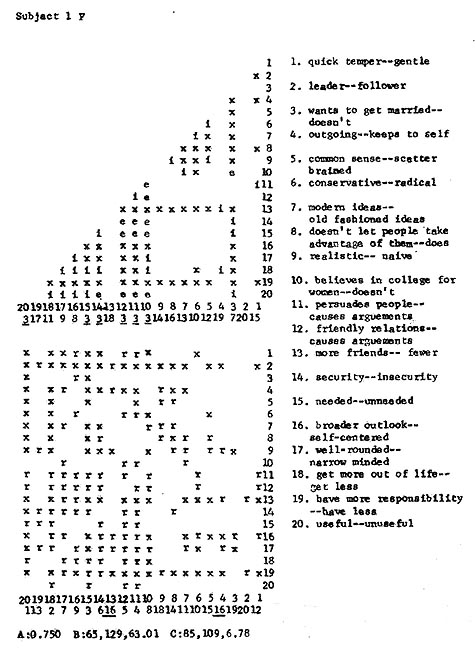 Subject
2
M
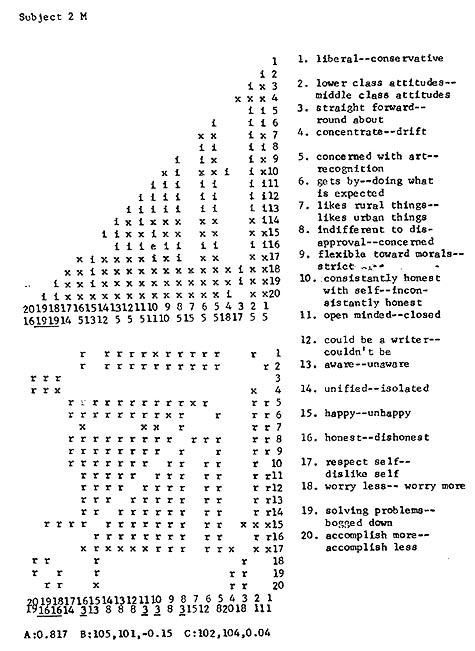 Subject
3
M
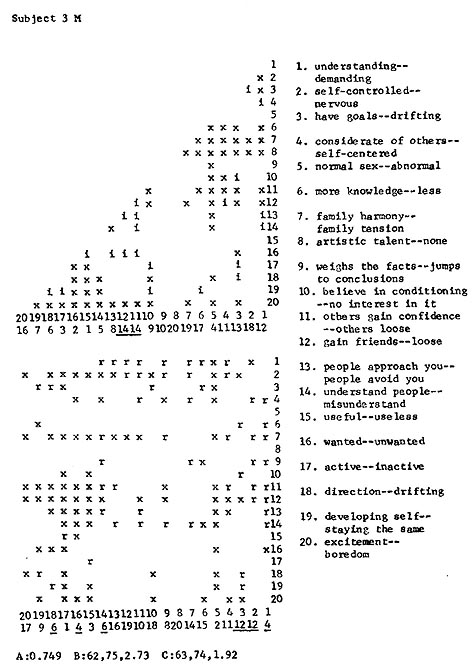 Subject
4
M
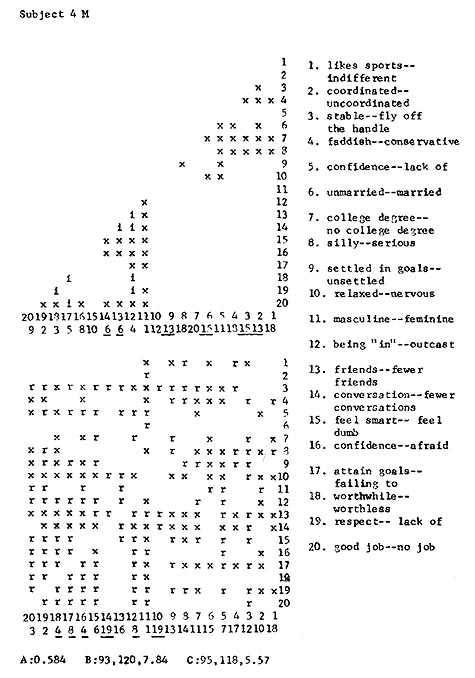 Subject
5
M
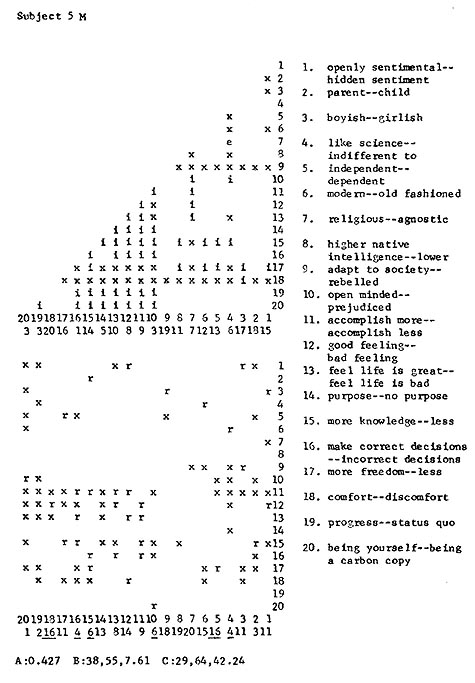 Subject
6
F
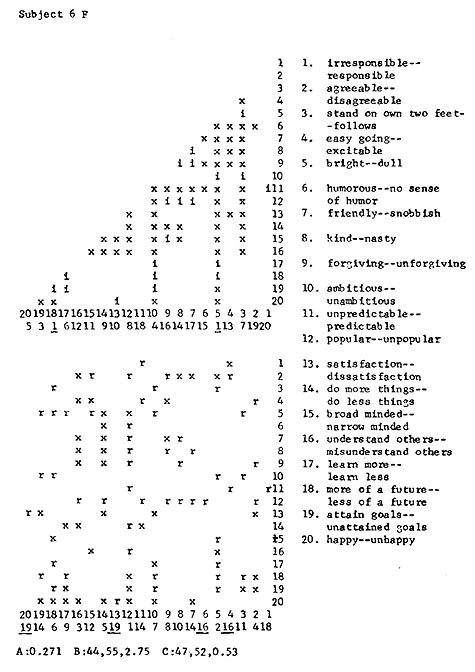 Subject 7 F 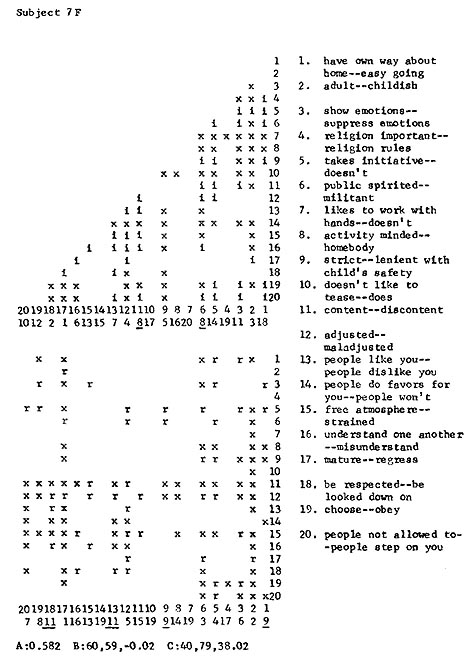 Subject 8 M 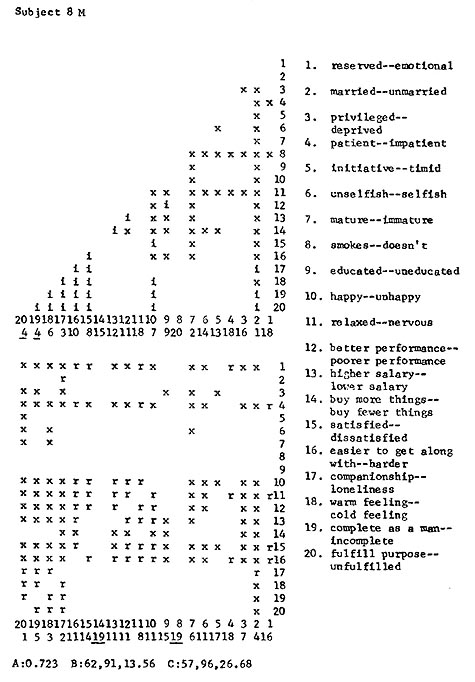 Subject 9 F 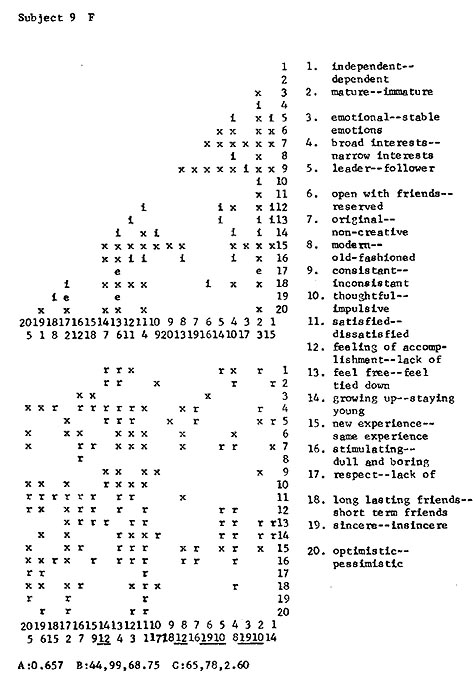 Subject 10 M 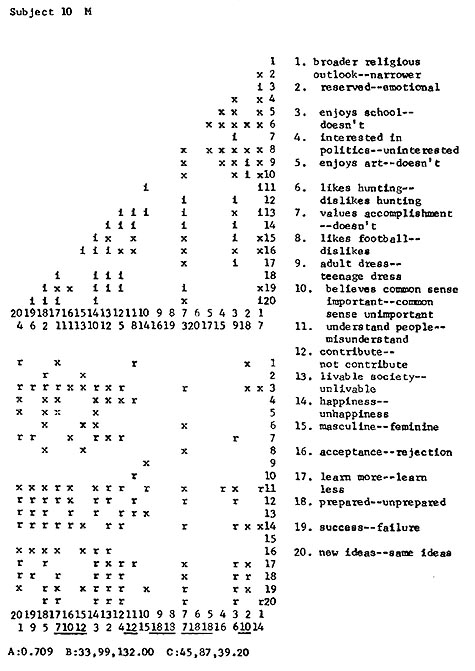 Subject 11 F 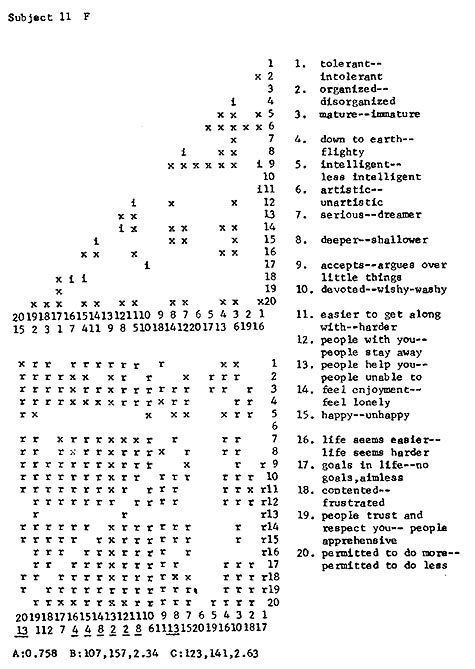 Subject 12 F 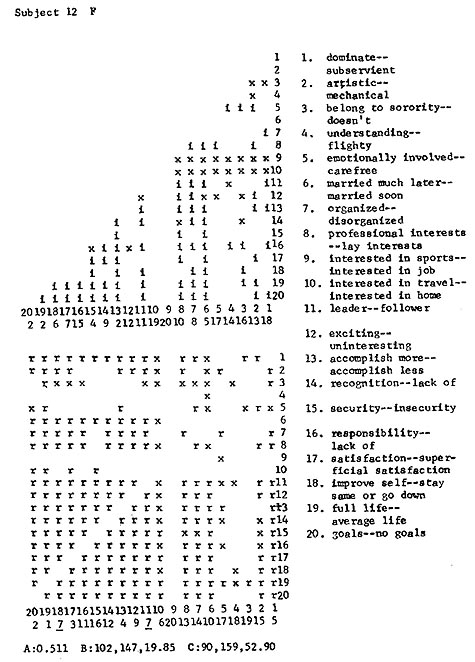 Subject 13 M 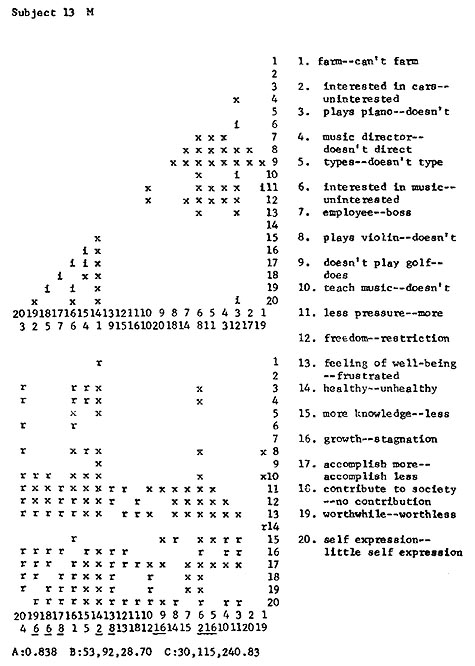 Subject 14 F 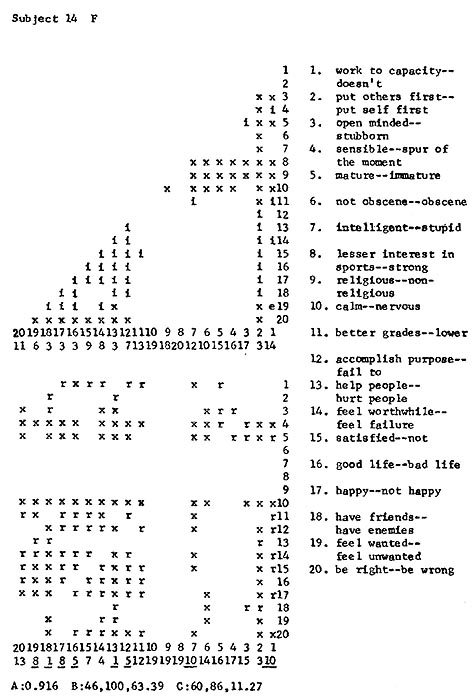 Subject 15 M 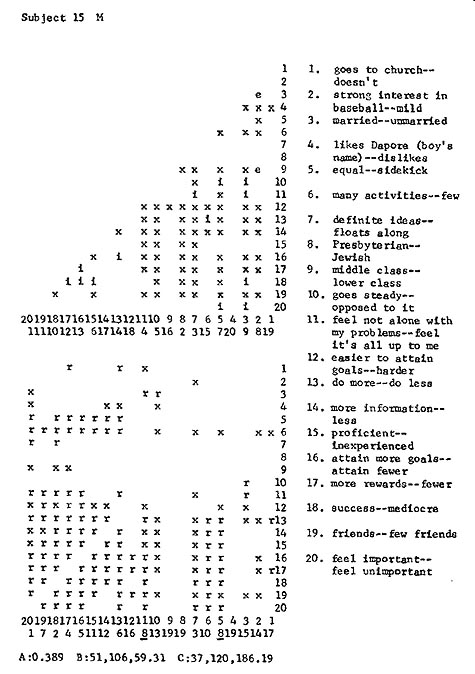 Subject 16 F 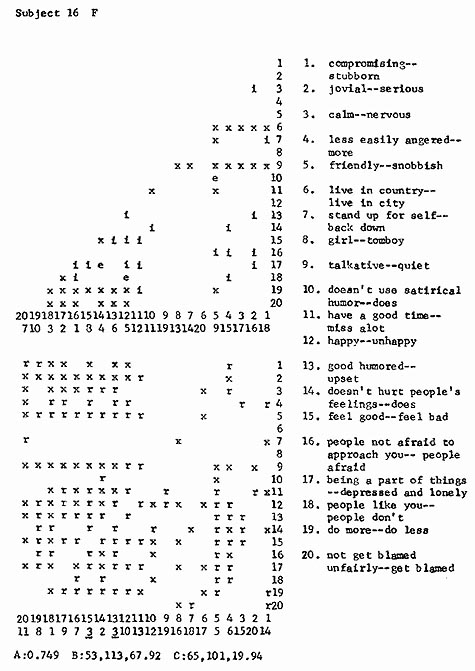 Subject 17 F 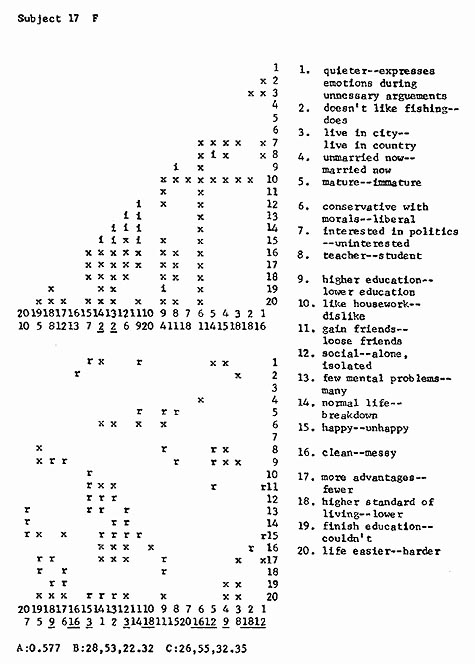 Subject 18 F 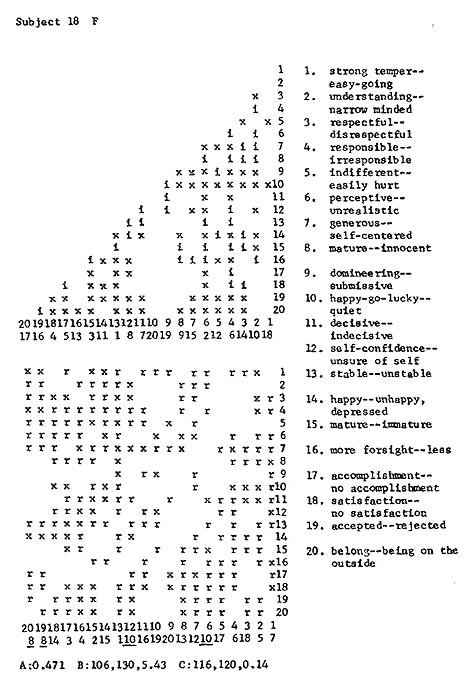 Subject 19 F 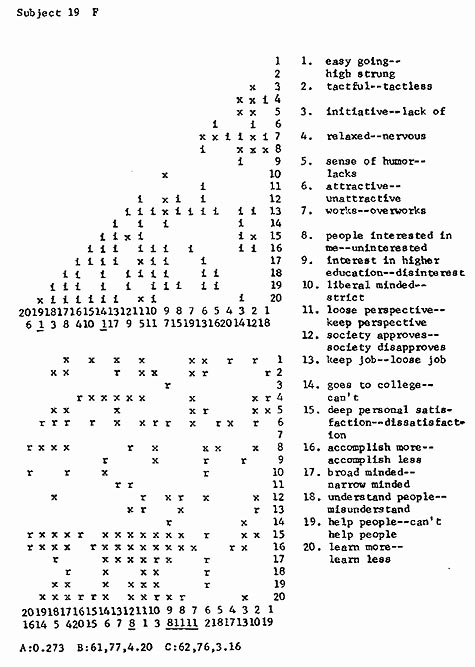 Subject 20 F 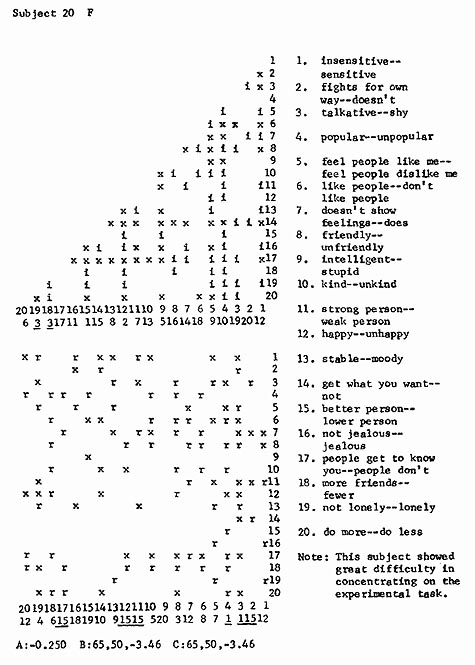 Subject 21 F 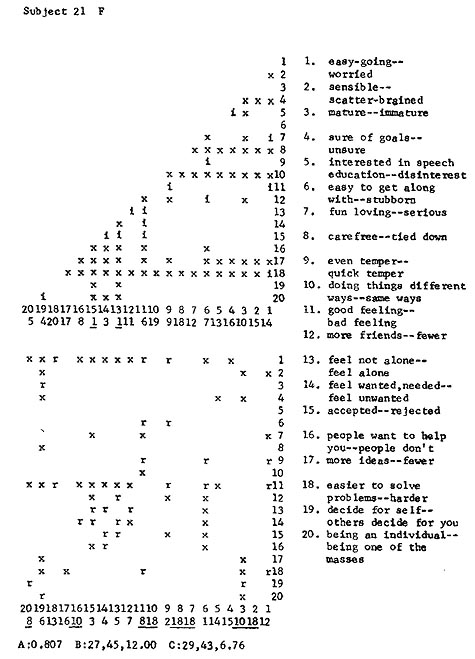 Subject 22 F 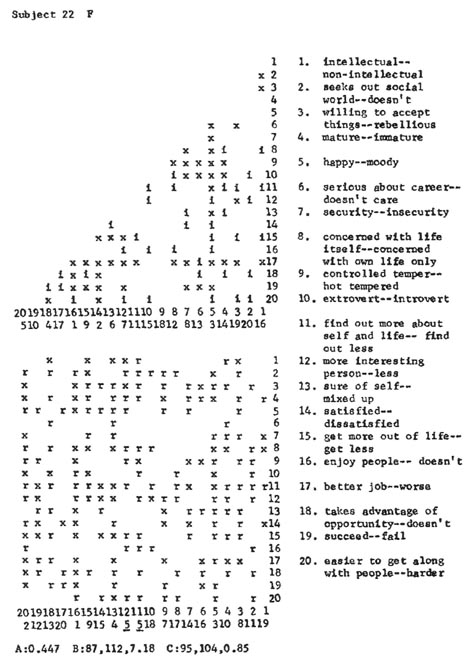 Subject 23 M 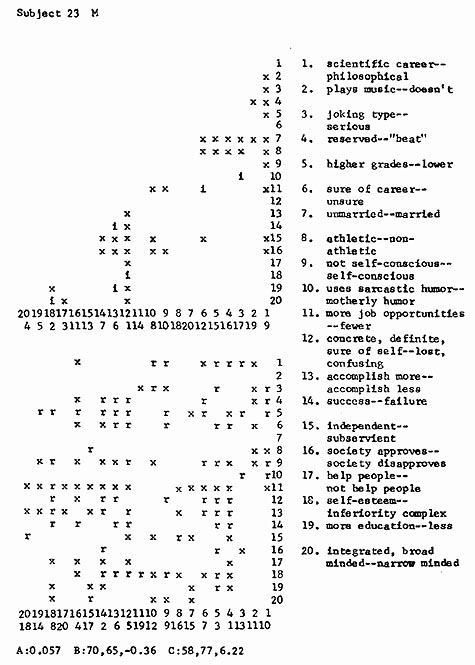 Subject 24 F 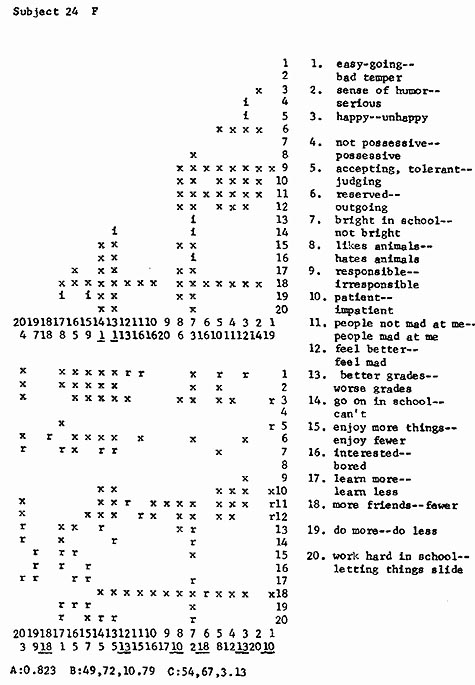 Subject 25 F 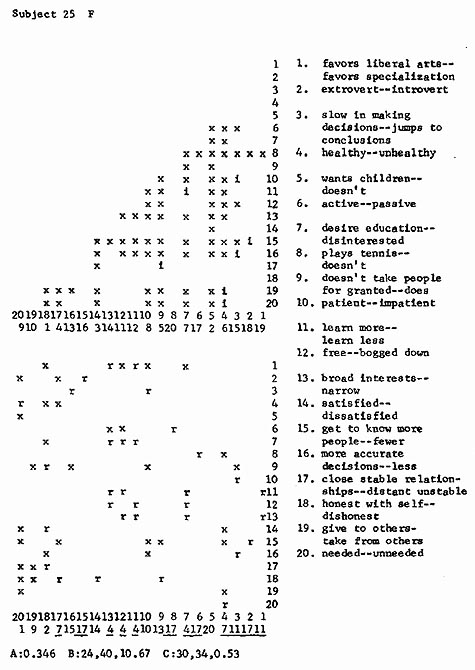 Subject 26 M 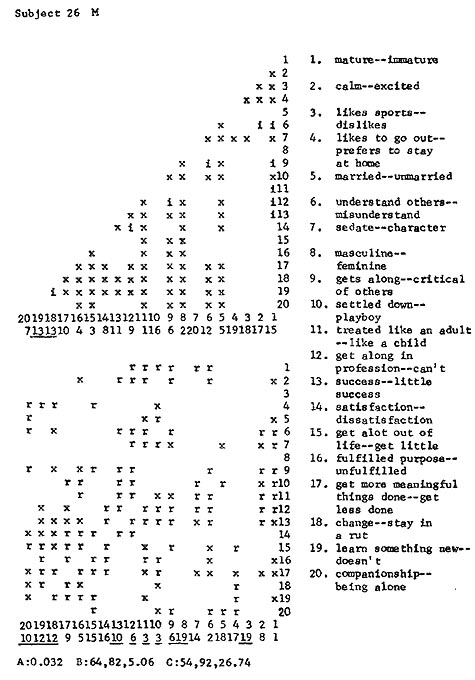 Subject 27 F 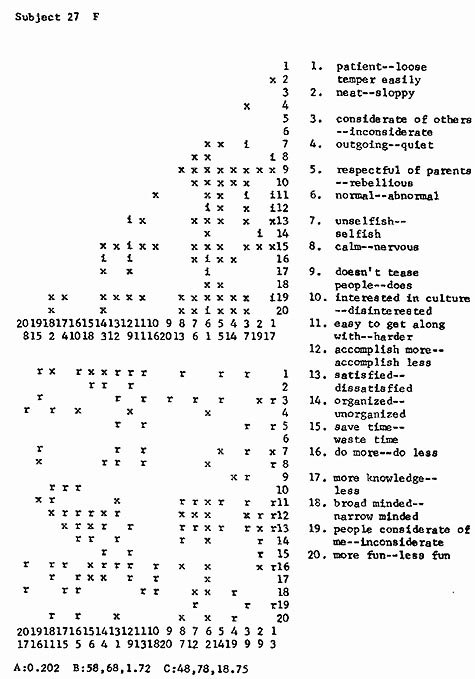 Subject 28 M 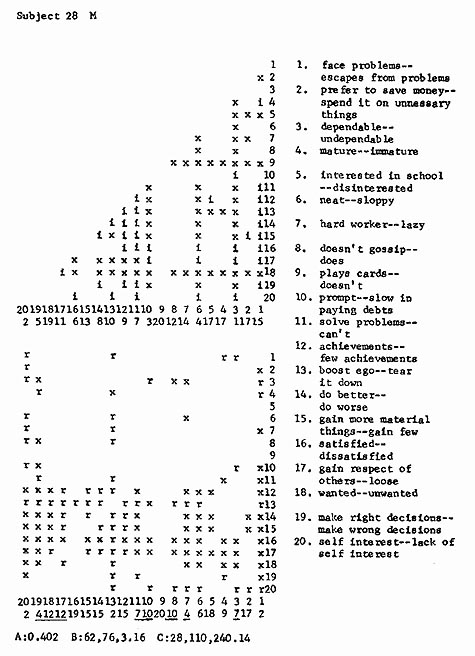 BIBLIOGRAPHY 1. Bannister, D. A genesis of schizophrenic thought disorder: a serial invalidation hypothesis. British J. of Psychiatry. 1963, 109, 680-686. 2. Bennion, R. C. A study of relative readiness for changing anticipations following discredit to situational behaviors: Hostility and the constellatoriness of personal constructs. Unpublished master's thesis, Ohio State Univer., 1959. 3. Bieri, J. A study of the generalization of changes within the personal construct system. Unpublished Ph.D. dissertation. Ohio State Univer., 1953. 4. Binner, P. R. Permeability and complexity: Two dimensions of cognitive structure and their relationship to behavior. Unpublished Ph.D. dissertation, Univer. of Colorado, 1958. 5. Bonarius, J. C. J. Research in the Personal Construct Theory of George A. Kelly. In Progress in experimental personality research. Brendan A. Maher (Ed). Vol. II, New York: Academic Press, 1965 (In press). 6. Cromwell, R. L. and Caldwell, D. F. A comparison of ratings based on personal constructs of self and others. J. clin. Psycho1., 1962, 18, 43-46. 7. Flynn, J, C, Cognitive complexity and construct constellatoriness as antecedant conditions of role variability. Unpublished master's thesis, Ohio State Univer., 1959. 8. Gottesman, L. E. The relationship of cognitive variables to therapeutic ability and training of client-centered therapists. J. consult. Psychol., 1962, 26, 119-125. 9. Guilford, J. P. Fundamental Statistics in Psychology and Education. New York: "McGraw-Hill, 1950-; 10. Hess, Harrie F. Level of cognitive awareness: Its measurement and relation to behavior. Unpublished Ph.D. dissertation, Univer. of Colorado, 1959. 11. Howard A. R. Psychological change as revealed by self-descriptions. Unpublished Ph.D. dissertation, Ohio State Univer., 1951. 108 109 12. Howard, A. R., and Kelly, G. A. A theoretical approach to psychological movement. J. abnorm, soc. Psychol,. 1954, 49, 399-404. 13. Isaacson, G. The meaningfulness of personal and cultural constructs. Unpublished master's thesis, Univer. of Missouri, 1962. 14. Jennings, C. L. Personal construct theory and the creativity cycle. Unpublished Ph.D. dissertation, Ohio State Univer., 1963. 15. Kelly, G. A. The psychology of personal constructs. 2 Vol. New York: W. W. Norton & Co., 1955. 16. Kelly, G. A. Hostility. Presidential address, Clinical Division American Psychological Association, 1957, Unpublished. 17. Kelly, G, A, Interdisciplinary collaboration. Presidential address, Consulting Division, American Psychological Association, 1957. Unpublished, 18. Kelly, G. A. Personal construct theory and the psychotherapeutic interview. Unpublished manuscript, 1957. 19. Kelly, G. A. The theory and technique of assessment. Annua1 Rev. Psvchol., 1958, 9, 323-352. 20. Kelly, G. A. Man's construction of his alternatives. In G. Lindzey (Ed.), The assessment of human motives. New York: Rinehert, 1953. 21. Kelly, G, A. The function of interpretation in psychotherapy. Three unpublished papers for institute sponsored by the Los Angeles Society of Psychologists in Private Practice and the U. of California at Los Angeles, Jan., 1959. 22. Kelly, G. A. Is treatment a good idea? In Howard, A. R, (Ed.), Therapeutic roles in patient treatment. Sheridan, Wyoming: Veterans Admin., Hospital, l959 pp. 20-25,(mimeographed). 23. Kelly, G. A. Theory and therapy in suicide: The personal point of view. In Shneidman and Farberow, (Ed.) The cry for help. New York: McGraw-Hill, 1961. 24. Kelly, G. A. A mathematical approach to psychology. Address to Moscow Psychological Society, 1961, 25. Kelly, G. A. The abstraction of human processes. In Proceedings of the XIV International Congress of Applied Psychology, Vol. 2: Personality Research. G. S, Nielson and Stanley Coopersmith, eds. Copenhagen: Munksgaard, 1962. 110 26. Kelly, G. A. Europe's matrix of decision. In Nebraska symposium on motivation,, 1962. M. R. Jones, (Ed.) Lincoln: Univer. of Nebraska Press, 1962, 27. Kelly, G. A. A further explanation of factor analysis. Unpublished manuscript, The Ohio State Univer., 1962. 28. Kelly, G. A. Sin and psychotherapy. Temple University symposium of psychotherapy, 1962, Unpublished MS, Ohio State Univer., 1962. 29. Kelly, G. A. In whom confide? On whom depend for what? The fourth annual Samuel H. Flowerman Memorial Lecture presented to the New York Society of Clinical Psychologists on Dec. 7, 1962. Unpublished MS, Ohio State Univer. 30. Kelly, G. A. Psychotherapy and the Nature of Man. Paper read at a symposium on the nature of man during meetings of the American Psychological Assoc. in Philadelphia, 1963. 31. Kelly, G. A. Nonparametric factor analysis of personality theories, J. Indiv. Psychol., 1963, 19, 115-147 32. Kelly, G. A. The language of hypothesis, J. Indiv, Psychol., 1964, 20, 137-152. 33. Kelly, G. A. The autobiography of a theory. Unpublished MS, Ohio State Univer., 1964. 34. Kelly, G. A. The psychology of the unknown. For proposed volume on the philosophy of science, Denis O1Donovan (Ed.). 35. Kelly, G. A. The threat of aggression. Paper presented at Conference on Humanistic Psychology, 1964. 36. Kelly, G. A. The strategy of psychological research. Paper presented at Brunel College, London. Bulletin British Psychological Society. 1965, 18, 1-15. 37. Kelly, G. A. A psychology of the optimal man. In forthcoming book, The goals of psychotherapy. A. Mahrer (Ed.). 38. Kelly, J. V. A program for processing George Kelly's Rep Grids on the IBM 1620 Computer. Unpublished MS, Ohio State Univer., 1963. 39. Ladwig, G. A. Slot-movement under conditions of threat. Unpublished master's thesis, The Ohio State Univer., I960. 40. Landfield, A. W. A study of threat within the psychology of personal constructs. Unpublished Ph.D. dissertation, The Ohio State Univer., 1951. 111 41. Landfield, A. W. A movement interpretation of threat. J, abnorm. soc. Psychol., 1954, 49, 529-532. 42. Landfield, A. W. Self-predictive orientation and the movement interpretation of threat. J. abnorm. soc. Psychol, 1955, 51, 434-438. 43. Landfield, A. W, The closeness of opposites. A synthesis and reorientation. Unpublished manuscript, Purdue Univer. 44. Landfield, A. W., & Fjeld, S. P. Threat and self-predictability with predictability of others controlled: An addendum. Psychol. Rep., I960, 6, 333-334. 45. Lemcke, Frances E. S. Some aspects of change process in personal construct systems. Unpublished Ph.D. dissertation, Ohio State Univer., 1959. 46. Levy, L. H. A study of the relative information value of constructs in personal construct theory. Unpublished Ph.D. dissertation, Ohio State Univer., 1954. 47. Levy, L. H. Personal constructs and predictive behavior. J. abnorm. soc. Psychol.. 1956, 51, 54-58. 48. Lundy, R. M, Changes in interpersonal perceptions associated with group psychotherapy. Unpublished master's thesis, Ohio State Univer., 1952. 49. Lundy, R. M. Assimilative projection and accuracy of prediction in interpersonal perceptions. J, abnorm, soc. Psychol., 1956, 52, 34-38. 50. Mitsos, S. B. Representative elements in role construct technique. J. consult. Psychol., 1958, 22, 311-313. 51. Newman, D. K. A study of factors leading to change within the personal construct system. Unpublished Ph.D. dissertation, Ohio State Univer., 1956, Dissertation Abstr., 1957, 17, 1597-1598. 52. Pedersen, F. A. A consistency study of the R.C.R.T. Unpublished master's thesis, Ohio State Univer., 1958. 53. Poch, S. M. A study of changes in personal constructs as related to interpersonal prediction and its outcome. Unpublished Ph.D. dissertation, Ohio State Univer., 1952. 54. Resnick, J., and Landfield, A. W. The oppositional nature of dichotomous constructs. Psychol. Rec., 1961, 11, 47-55. 55. Siege1, A. Nonparametric Statistics for the Behavioral Sciences, New York: McGraw-Hill, 1956. 56, Slater, P. The principal components of a repertory grid. 10 Blomfield St. London, EC 2.: Vincent Andrews & Co., 1965. |
||||||||||||||||||||||||
AUTOBIOGRAPHY  I,
Dennis
Neil Hinkle, was born in Akron, Ohio, June 21, 1935. I received my
secondary
education in the public schools of Texas, Florida, Missouri, Indiana,
and Ohio.
I attended Purdue University, Miami University, and following a period
of
service in the armed forces, I received the degree Bachelor of Arts in
1959 and
the degree Master of Arts in 1962 from The Ohio State University. While
enrolled
in the Graduate School I received appointments as a United States
Public Health
Fellow in 1960-61 and Teaching Assistant for the years 1961-62 and
1963-64. As
part of the training program in clinical psychology I completed a
one-year
internship at the Palo Alto Veterans Administration Hospital, Palo
Alto,
California, in 1962-63. The requirements for the degree Doctor of
Philosophy
were completed in 1964-65 during an appointment as Psychology Trainee
at the
Veterans Administration Hospital, Chillicothe, Ohio. I,
Dennis
Neil Hinkle, was born in Akron, Ohio, June 21, 1935. I received my
secondary
education in the public schools of Texas, Florida, Missouri, Indiana,
and Ohio.
I attended Purdue University, Miami University, and following a period
of
service in the armed forces, I received the degree Bachelor of Arts in
1959 and
the degree Master of Arts in 1962 from The Ohio State University. While
enrolled
in the Graduate School I received appointments as a United States
Public Health
Fellow in 1960-61 and Teaching Assistant for the years 1961-62 and
1963-64. As
part of the training program in clinical psychology I completed a
one-year
internship at the Palo Alto Veterans Administration Hospital, Palo
Alto,
California, in 1962-63. The requirements for the degree Doctor of
Philosophy
were completed in 1964-65 during an appointment as Psychology Trainee
at the
Veterans Administration Hospital, Chillicothe, Ohio. |
||||||||||||||||||||||||
| |
||||||||||||||||||||||||
ABOUT
THE
AUTHOR (2010) Dennis Hinkle received his PhD in 1965 from
Ohio
State University. He studied with George A. Kelly from 1960 to 1965,
then
followed him to Brandeis University, Waltham, MA, where he remained
until
Kelly’s death in 1967. Dennis taught doctoral level psychology at
several universities
until 1975 when he established an independent practice in the San
Francisco Bay
area. Her was married for 20 years and fathered three sons. He is
blissfully
retired with his former graduate student and partner of 36 years. His
male
partner is also a clinical psychologist. Dennis Hinkle received his PhD in 1965 from
Ohio
State University. He studied with George A. Kelly from 1960 to 1965,
then
followed him to Brandeis University, Waltham, MA, where he remained
until
Kelly’s death in 1967. Dennis taught doctoral level psychology at
several universities
until 1975 when he established an independent practice in the San
Francisco Bay
area. Her was married for 20 years and fathered three sons. He is
blissfully
retired with his former graduate student and partner of 36 years. His
male
partner is also a clinical psychologist.Email: garden@directcon.net Correspondence address: Dennis Hinkle 7610 Kona Court, Placerville, CA, 95667, USA, |
||||||||||||||||||||||||
| |
||||||||||||||||||||||||
| REFERENCE Hinkle, D. N. (2010). The change of personal constructs from the viewpoint of a theory of construct implications. (PhD dissertation, Ohio State University, 1965). Personal Construct Theory & Practice, 7, Suppl. No 1, 1-61, 2010 (Retrieved from http://www.pcp-net.org/journal/pctp10/hinkle1965.html) |
||||||||||||||||||||||||
| |
||||||||||||||||||||||||
| Received: 10 Aug
2010 - Accepted: 12 Aug 2010 – Published 31 Aug 2010 |
||||||||||||||||||||||||
| |
ISSN 1613-5091
| Last update 31 August 2010 |